We use essential cookies to make Venngage work. By clicking “Accept All Cookies”, you agree to the storing of cookies on your device to enhance site navigation, analyze site usage, and assist in our marketing efforts.
Manage Cookies
Cookies and similar technologies collect certain information about how you’re using our website. Some of them are essential, and without them you wouldn’t be able to use Venngage. But others are optional, and you get to choose whether we use them or not.
Strictly Necessary Cookies
These cookies are always on, as they’re essential for making Venngage work, and making it safe. Without these cookies, services you’ve asked for can’t be provided.
Show cookie providers
- Google Login
Functionality Cookies
These cookies help us provide enhanced functionality and personalisation, and remember your settings. They may be set by us or by third party providers.
Performance Cookies
These cookies help us analyze how many people are using Venngage, where they come from and how they're using it. If you opt out of these cookies, we can’t get feedback to make Venngage better for you and all our users.
- Google Analytics
Targeting Cookies
These cookies are set by our advertising partners to track your activity and show you relevant Venngage ads on other sites as you browse the internet.
- Google Tag Manager
- Infographics
- Daily Infographics
- Graphic Design
- Graphs and Charts
- Data Visualization
- Human Resources
- Training and Development
- Beginner Guides
Blog Marketing

How to Create a Competitor Analysis Report (with Examples)
By Midori Nediger , Nov 09, 2023
Your business will always have competition.
And if you don’t know what that competition is up to, you could be missing out on huge opportunities.
That’s why a competitive analysis is so crucial to your success as a business. It gives you the tools to quickly adapt to any changes in the competitive landscape and potentially capitalize on industry trends that your competitors haven’t even noticed.
So let’s get some basics out of the way…
What is a competitive analysis report?
A competitive analysis report outlines the strengths and weaknesses of your competitors compared to those of your own business.
Typically, a competitive analysis report will contain:
- A description of your business’s target market
- Details about the features of your product compared to your competitors’ products
- A breakdown of current and projected market share, sales, and revenues
- Comparisons of pricing models
- An analysis of marketing strategy and social media strategy
- A description of customer ratings of the features of each competitor
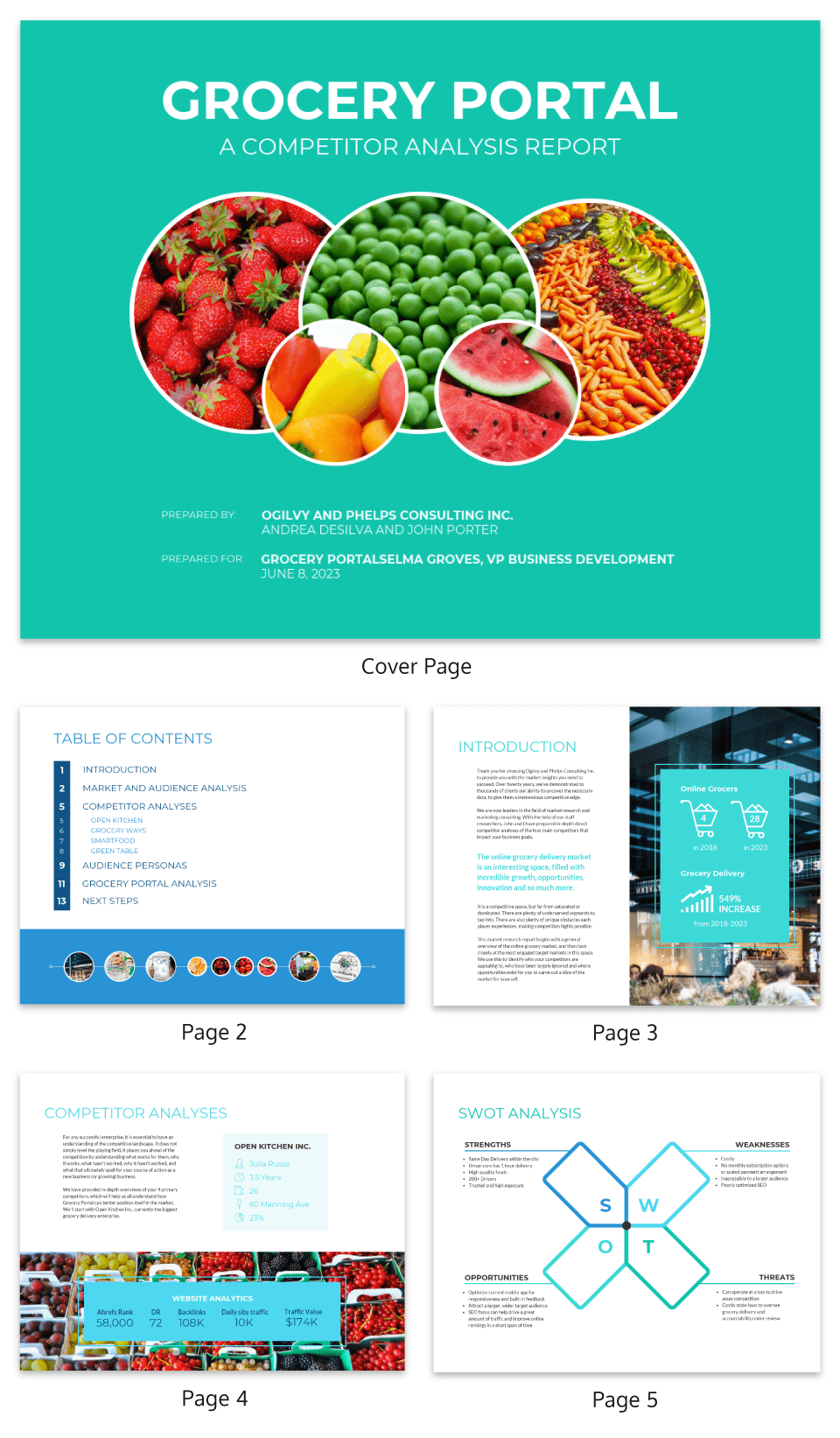
Whether you’re a startup trying to break into the marketplace , a consultant trying to get results for your client, or an established company looking to cement your foothold against the competition, a well-researched competitive analysis gives you the tools you need to make strategic decisions.
Your competitive analysis should inform your marketing plan , your business plan , your consultant report and every part of your high-level business strategy.
But how do you actually create a competitive analysis report?
How to make competitor analysis report :
- Start with a competitor overview
- Conduct market research to uncover customer personas and industry trends
- Compare product features in a feature comparison matrix
- Summarize your strengths and weaknesses with a SWOT analysis
- Show where you fit in the competitive landscape
- Use a competitor analysis template for a professional look and feel
The level of detail you include in each section of your competitive analysis report will vary depending on the stage of your business growth and your goals. For example, a startup might create a report that focuses on market research, while an established business might dive into detail on an emerging competitor.
But let’s talk about the parts of a competitive analysis that every report should include.
1. Start with a competitor overview
A strong report shows exactly what a company must out-compete to be successful.
Meaning you must audit any product or service that currently solves the problem your business is trying to solve for customers and write a quick profile for each competitor.
Like the template below, each competitor profile might include:
- The company’s revenue and market share
- The company’s size and information about their management team
- A broad description of the company’s strengths and weaknesses
- An overview of how the company is perceived by customers
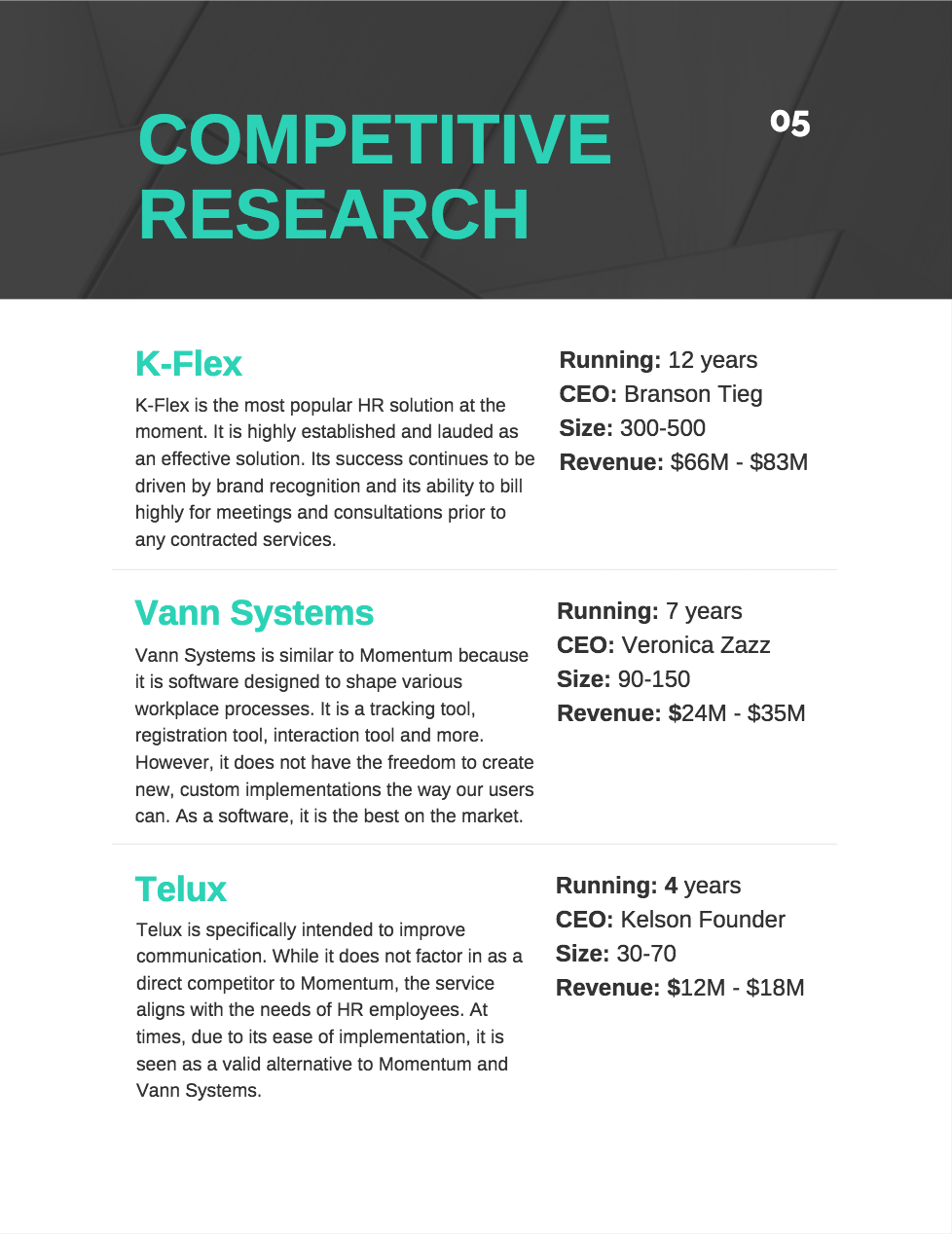
This overview will help your readers get a big-picture view of the market landscape.
2. Conduct market research to uncover customer personas and industry trends
You can’t create a competitive analysis report without doing extensive market research , which is all about gathering information to understand your customers, identify opportunities to grow, and recognize trends in the industry.
This research can help you put together the customer personas that will guide business and marketing decisions down the line, and allow you to plan for any shifts that might disrupt the marketplace.
You can conduct primary market research, with:
- Customer interviews
- Online surveys or questionnaires
- In-person focus groups
- Purchasing a competitor product to study packaging and delivery experience
Or secondary market research, by:
- Reading company records
- Examining the current economic conditions
- Researching relevant technological developments
When assembling your market research you may just want provide a high-level summary of the industry trends, like this competitor analysis example shows:
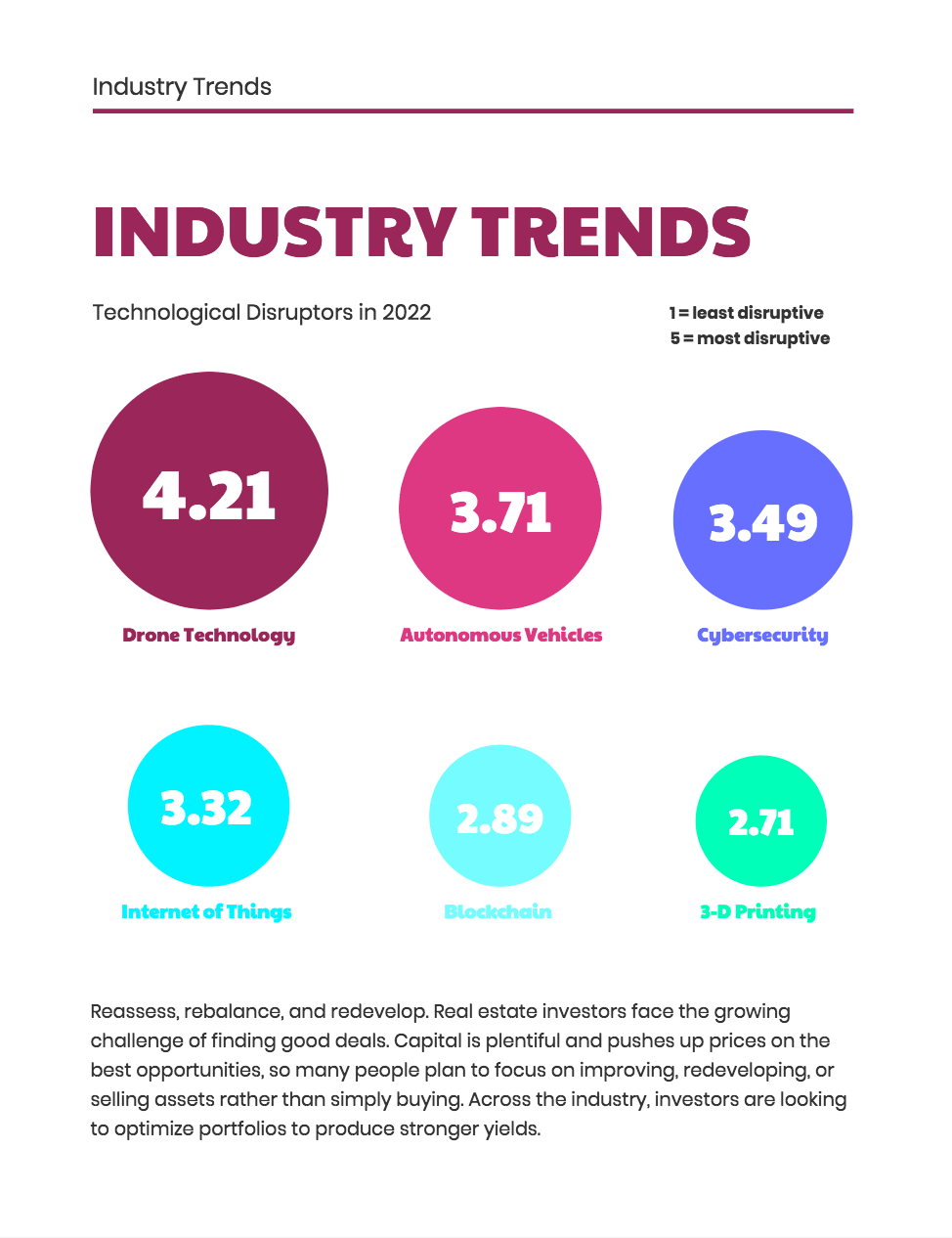
Or you may want to dive into detail on the demographics of a particular consumer segment, like this:
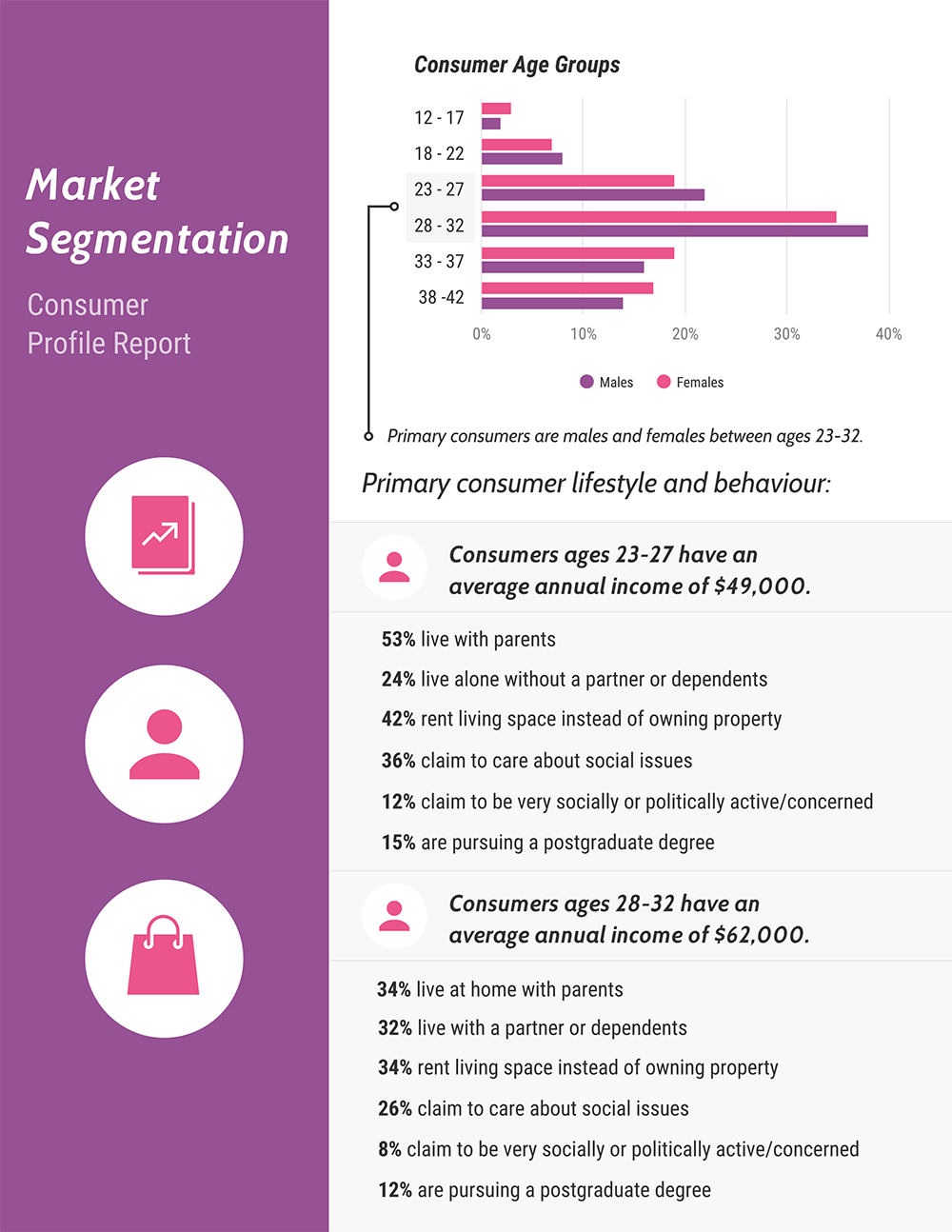
But if you’re a consultant or advisor struggling to get buy-in from skeptical stakeholders, the report below would be ideal. Covering everything from market forecasts to consumer profiles, it can help you get clients and decision-makers on board.
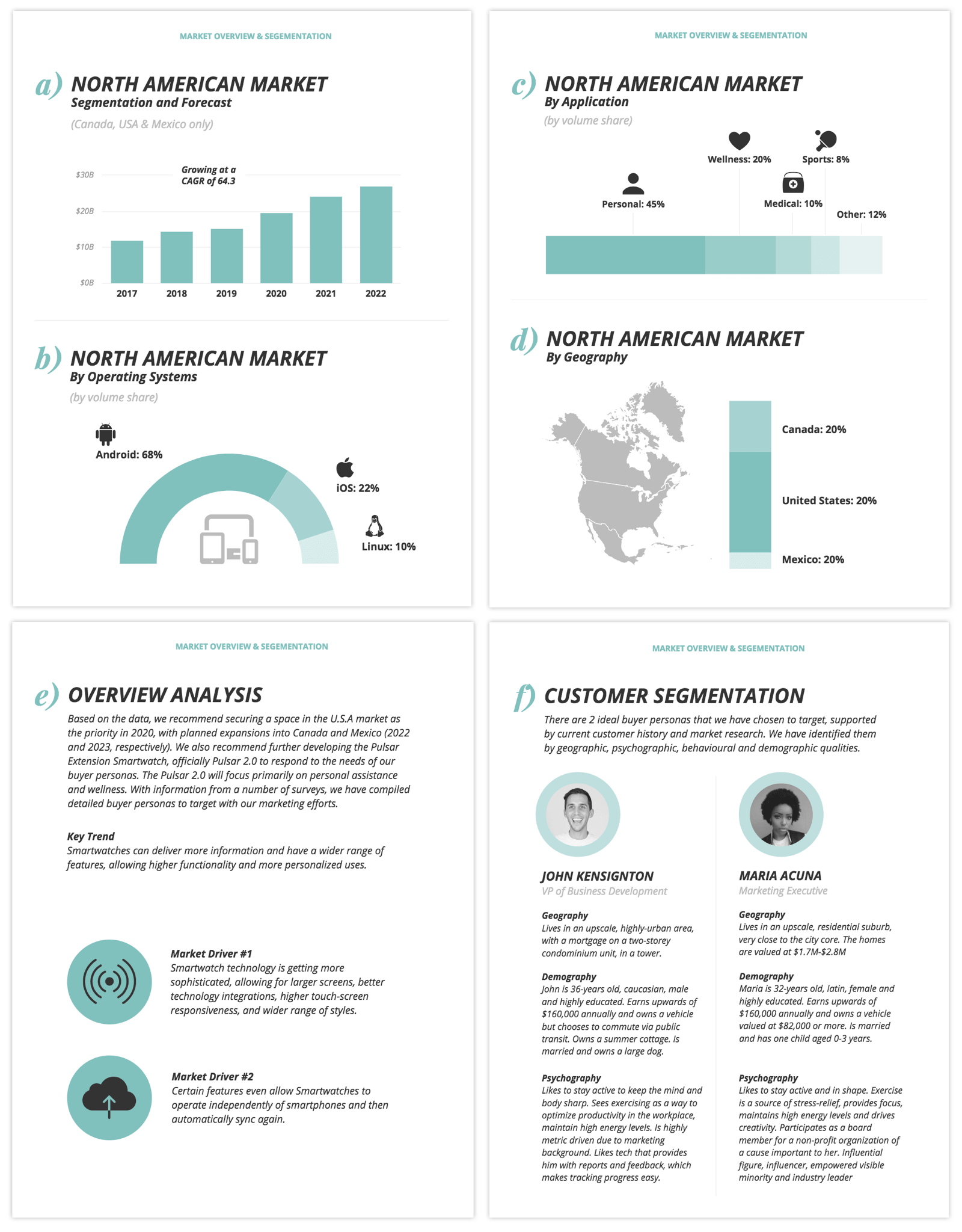
3. Compare product features in a feature comparison matrix
The feature comparison is arguably the most important part of the competitive analysis. Breaking down your product and your competitors’ products feature-by-feature will allow you to see what really sets everyone apart.
In addition to specific product features, here are some attributes that you might include in a feature comparison matrix:
- Product quality
- Number of features
- Ease of use
- Customer support
- Brand/style/image
The most common format for a features analysis is a simple matrix with you and your competitors along one side and all of the relevant features along the other. You can check off or rate how you perform in each area:
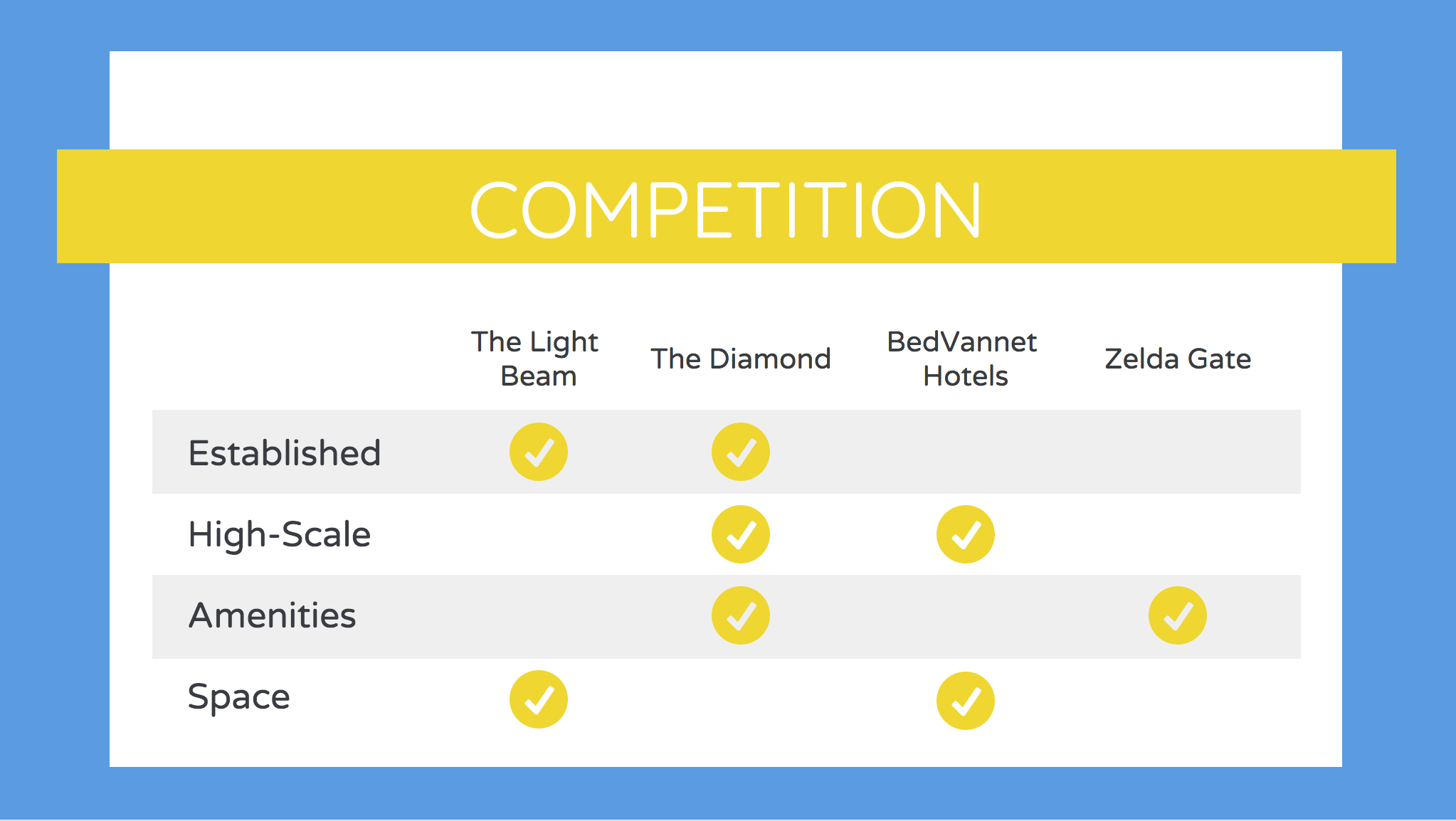
But these tables can get pretty long. Another approach is to focus on the things that provide the most value to the user, like in this competitor analysis example from Mint. It only includes ease of use, costs, and benefits:
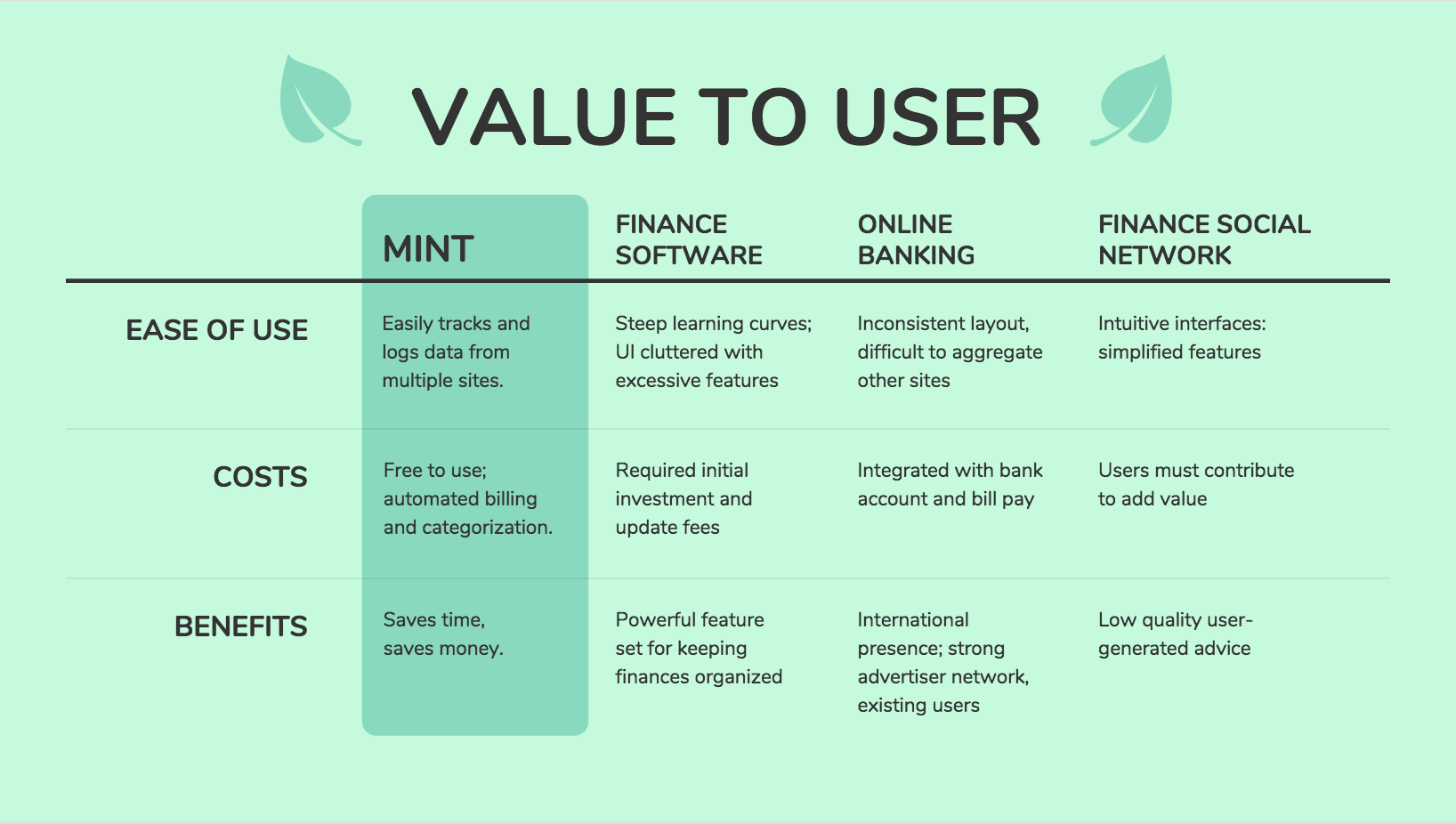
If you want to visualize your comparisons in an engaging way, you could use a comparison infographic .
Great resources for this section of your competitive analysis report are product rating sites like Capterra and G2Crowd . They’ll give you an unbiased view of your company and your competitors.
And as with any market research, it’s critical that you speak with real people who use your product and your competitors’ products. That’s the only way to get an accurate picture of how your target customers rate the competition .
4. Summarize your strengths and weaknesses in a SWOT analysis
When you’re conducting research for your competitive analysis, it’s going to be messy. You’ll have a lot of data and it’ll be hard for an outsider to understand.
That’s what makes the SWOT analysis so essential.
A SWOT analysis is a framework for evaluating your competitive position by listing your key strengths, weaknesses, opportunities, and threats.
It can act like a short summary of the rest of your competitive analysis report for anyone who doesn’t have time to dig into the details.
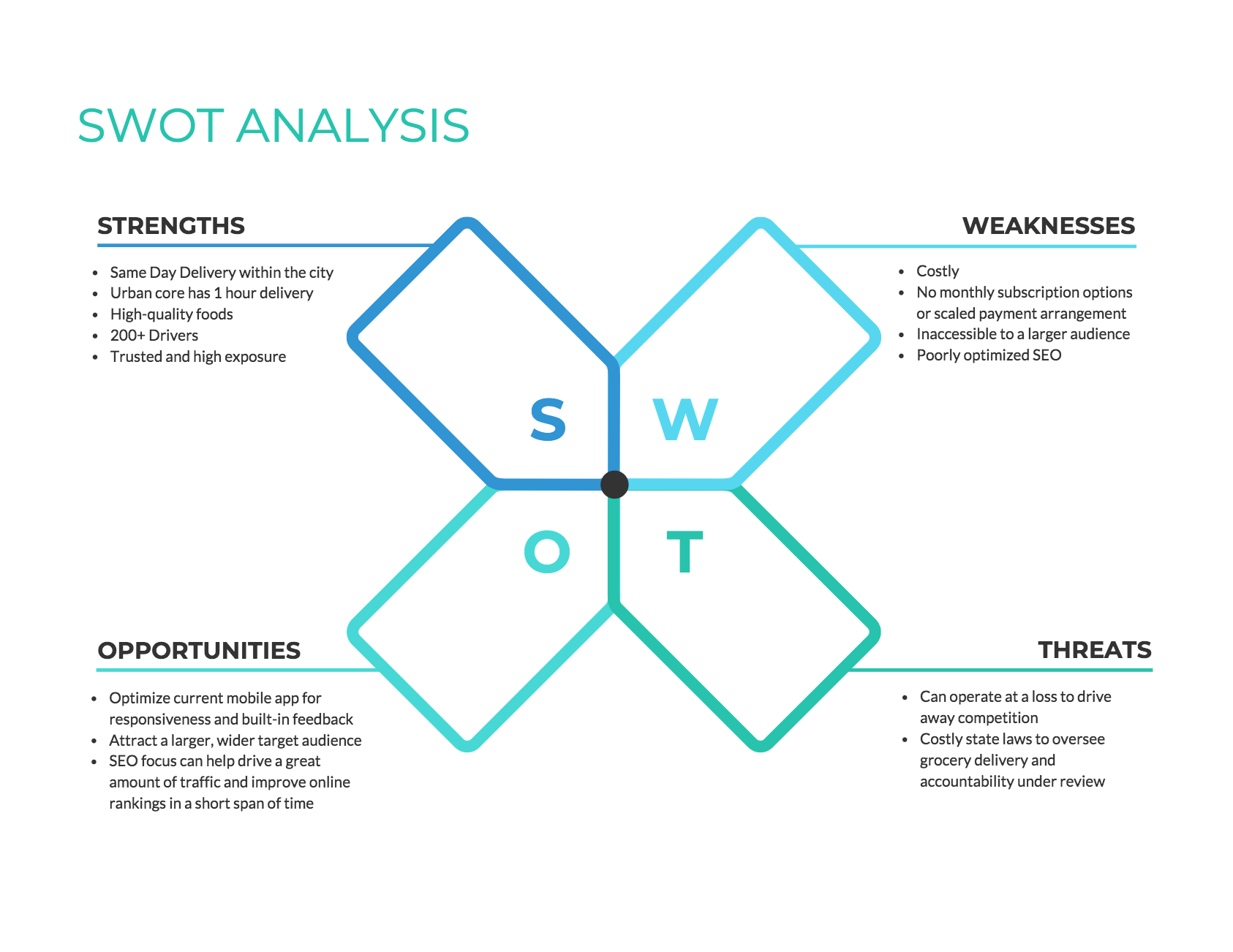
Click the template above to enter our online SWOT analysis maker tool. Customize the template to your liking–no design no-how required.
Here are some questions to kickstart your SWOT analysis:
- Strengths: What are we doing really well (in terms of marketing, products, sales, branding, technology, etc.)?
- Weaknesses: What are we struggling with? What’s holding us back?
- Opportunities: What’s the weakest area for our biggest competitor? Are there any gaps in the market that aren’t current being addressed? What has recently changed in our business or the market?
- Threats: What is our biggest competitor doing much better than us? What new products/features are they working on? What problems aren’t we currently addressing?
In your report, you could arrange your SWOT analysis in a simple list, but it can be helpful to use color-coded quadrants, like the competitor analysis example below. Note how each quadrant is paired with an icon:
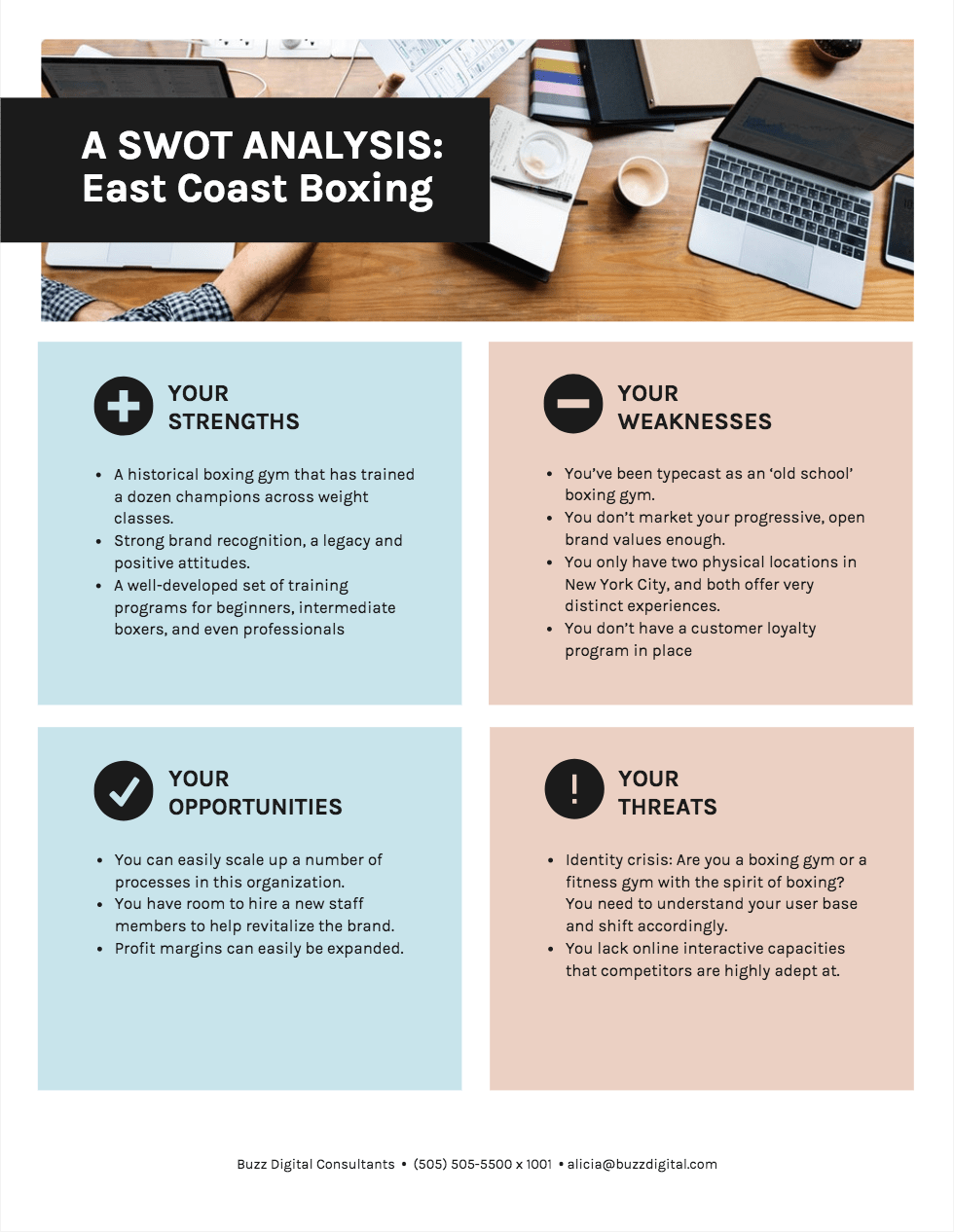
5. Show where you fit in the competitive landscape
After summarizing your strengths, weaknesses, opportunities, and threats, it’s time to look at the bigger picture. It’s time to figure out where every major competitor currently fits into the competitive landscape.
The most popular way of doing this is to identify the two dimensions that are most important for being competitive in your industry and plot them on a matrix, like this one from the Boston Consulting Group:
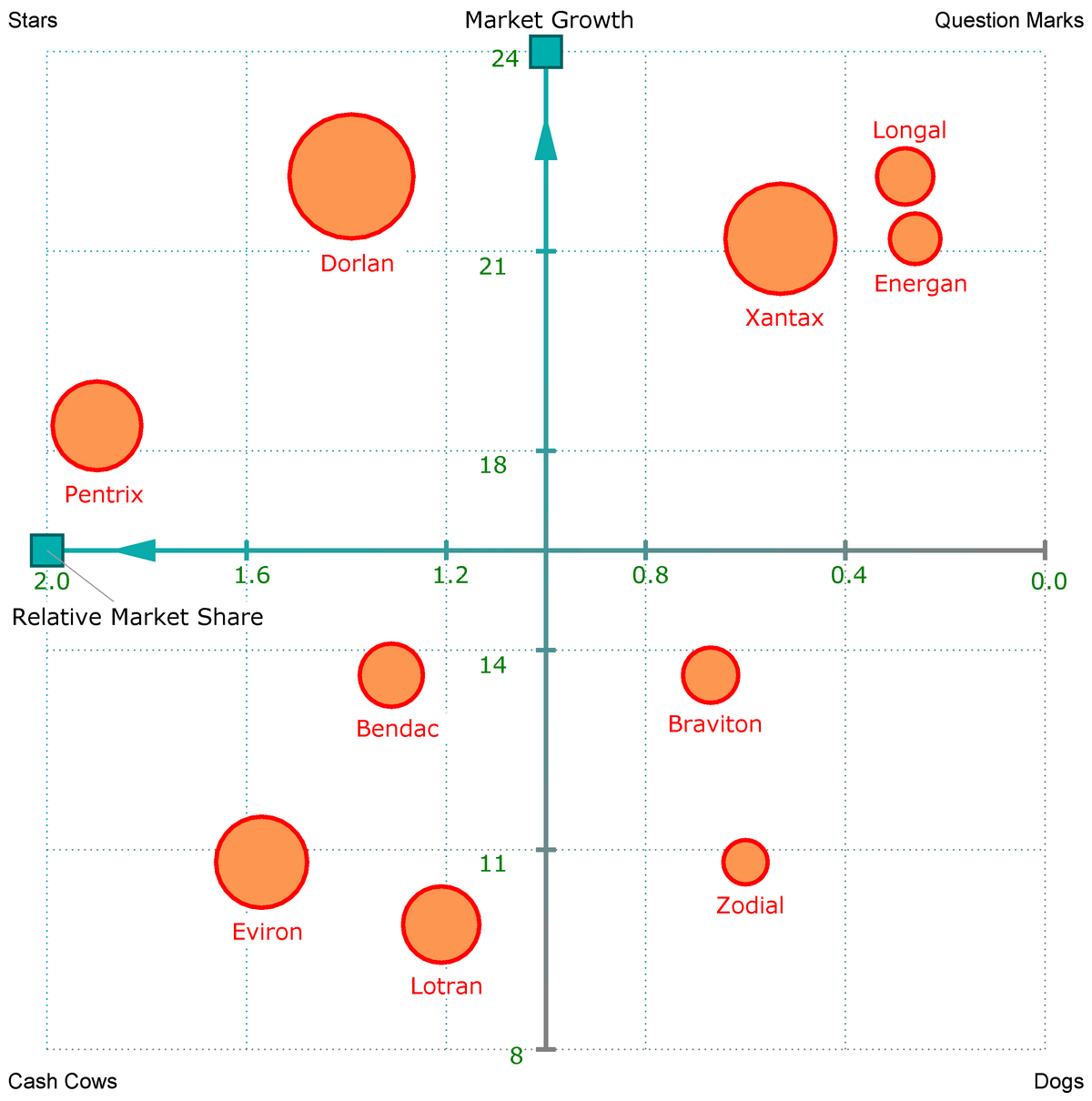
And this one from G2 Crowd (which looks at market presence and customer satisfaction):
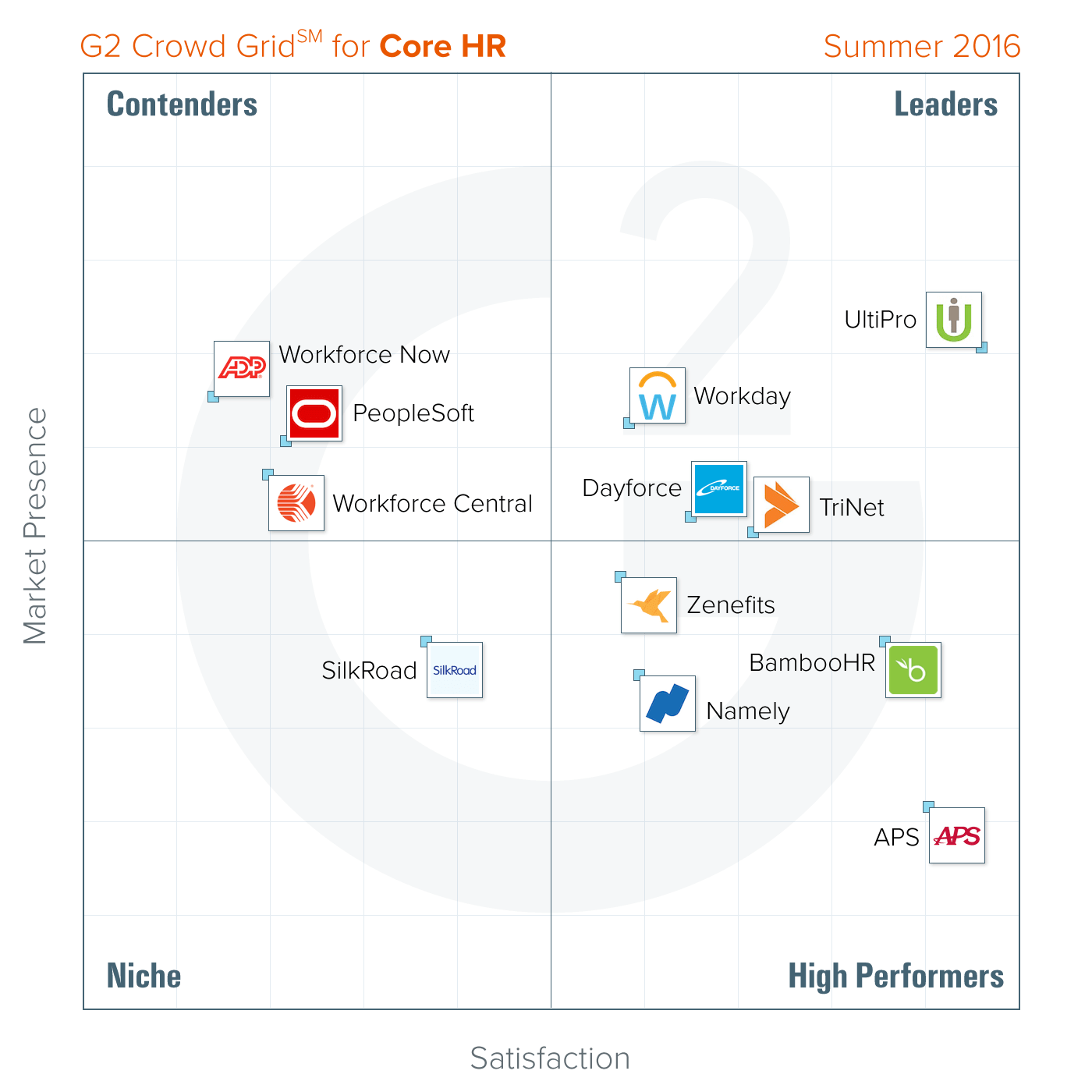
You may want to focus on where you fit in the market landscape based on your own biggest strengths and weaknesses, or the biggest threats and opportunities you identified in the SWOT analysis.
Or, it may be enough just to summarize in words the features and benefits that set your apart from your competitors (which is a great way to end your report on a high note).
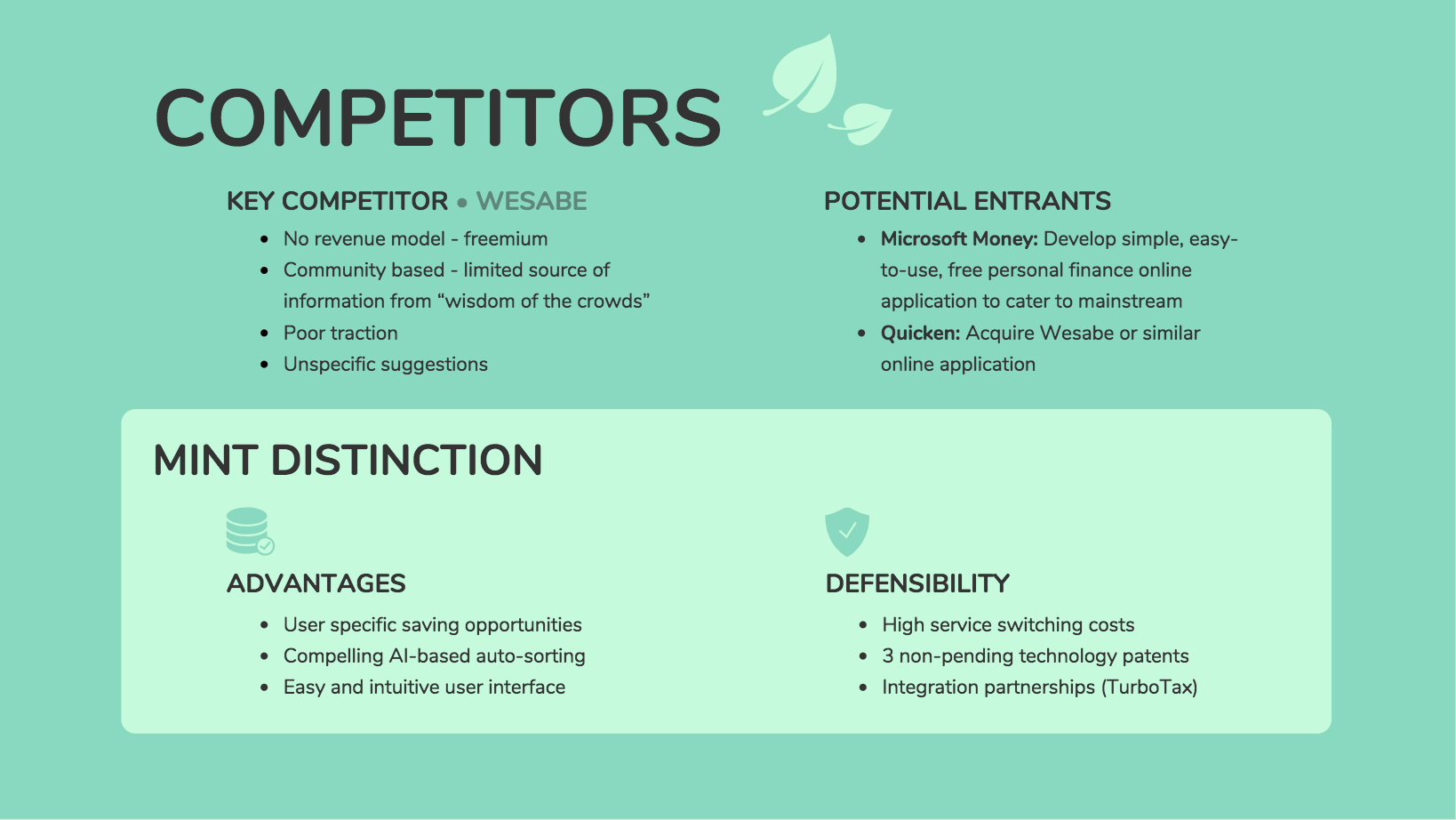
Competitor analysis examples for strategic planning
Let’s delve into some competitor analysis examples that can empower your organization to navigate the market effectively.
1. Competitor analysis example for marketing specialists
Imagine this: You are a Marketing Specialist and your goal is to establish a strong online presence and attract a diverse user base. However, you face stiff competition from established players in the market. Here are some things you should look into when doing your competitor analysis:
Competitor analysis focus:
- SEO strategies: Analyze competitors’ websites to understand their SEO strategies. Identify high-ranking keywords, backlink strategies, and content optimization techniques . Alternatively, if you’re running a local business, you might want to analyze and scrape Google Maps listings to better assess how companies are optimizing Google My Business to generate leads.
- Social media engagement: Examine competitors’ social media presence. Evaluate the type of content that garners engagement, the frequency of posts, and audience interactions.
- Online advertising: Investigate competitors’ online advertising campaigns. Are they leveraging Google Ads, social media ads, or other platforms? Assess the messaging, visuals, and targeting criteria.
- Content marketing: Scrutinize competitors’ content marketing efforts. Identify the topics that resonate with their audience, the formats they use (blogs, videos, infographics), and the platforms they prioritize.
Here’s a SWOT analysis template to help you get started:
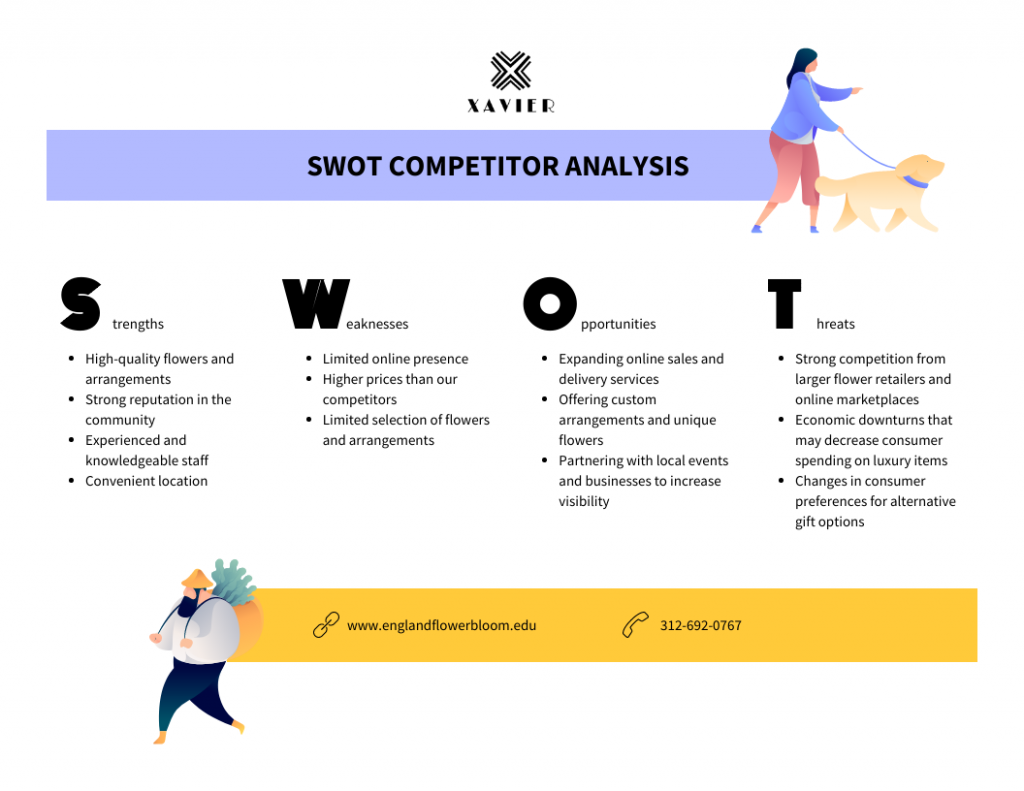
2. Competitor analysis example for SME business development managers
Imagine this: As the business development manager for a medium sized start up, you are tasked with expanding the client base. The market is crowded with similar service providers, and differentiation is key. When doing your competitor analysis report, look into:
- Client testimonials and case studies: Explore competitors’ websites for client testimonials and case studies. Identify success stories and areas where clients express satisfaction or dissatisfaction.
- Service offerings: Analyze the range of services offered by competitors. Identify gaps in their offerings or areas where you can provide additional value to clients.
- Pricing models: Investigate competitors’ pricing structures. Are they offering packages, subscription models, or customized solutions? Determine whether there’s room for a more competitive pricing strategy.
- Partnerships and collaborations: Explore potential partnerships or collaborations that competitors have formed. This can provide insights into untapped markets or innovative service delivery methods.
Here’s a competitor analysis comparison chart template that you could use:
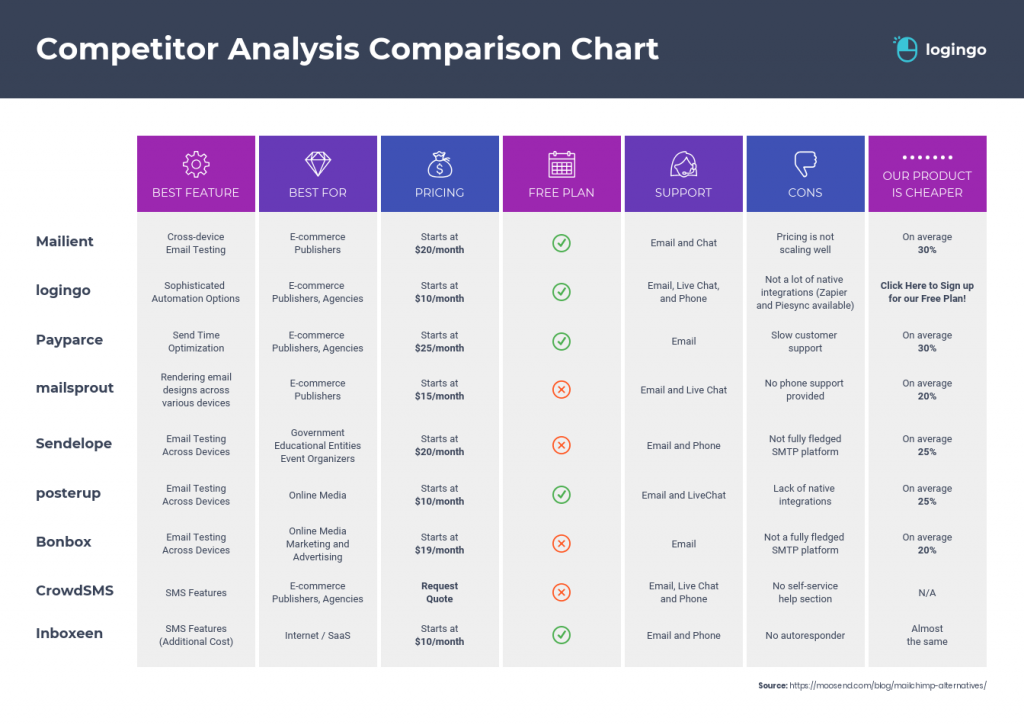
3. Competitor analysis example for product managers
Imagine this: You are a Product Manager for a consumer electronics company tasked with improving your company’s products and services. The market is buzzing with innovation, and staying ahead requires a deep understanding of competitor products.
- Feature comparison: Conduct a detailed feature-by-feature comparison of your product with competitors. Identify unique features that set your product apart and areas where you can enhance or differentiate.
- User experience (UX): Evaluate the user experience of competitors’ products. Analyze customer reviews, app ratings, and usability feedback to understand pain points and areas for improvement.
- Technological advancements: Investigate the technological capabilities of competitors. Are they integrating AI, IoT, or other cutting-edge technologies? Assess whether there are emerging technologies you can leverage.
- Product lifecycle management: Examine competitors’ product release cycles. Identify patterns in their product launches and assess whether there are opportunities for strategic timing or gap exploitation.
To help you get started, use this competitive analysis report template to identify the strengths, weaknesses, opportunities and threats of the product or service
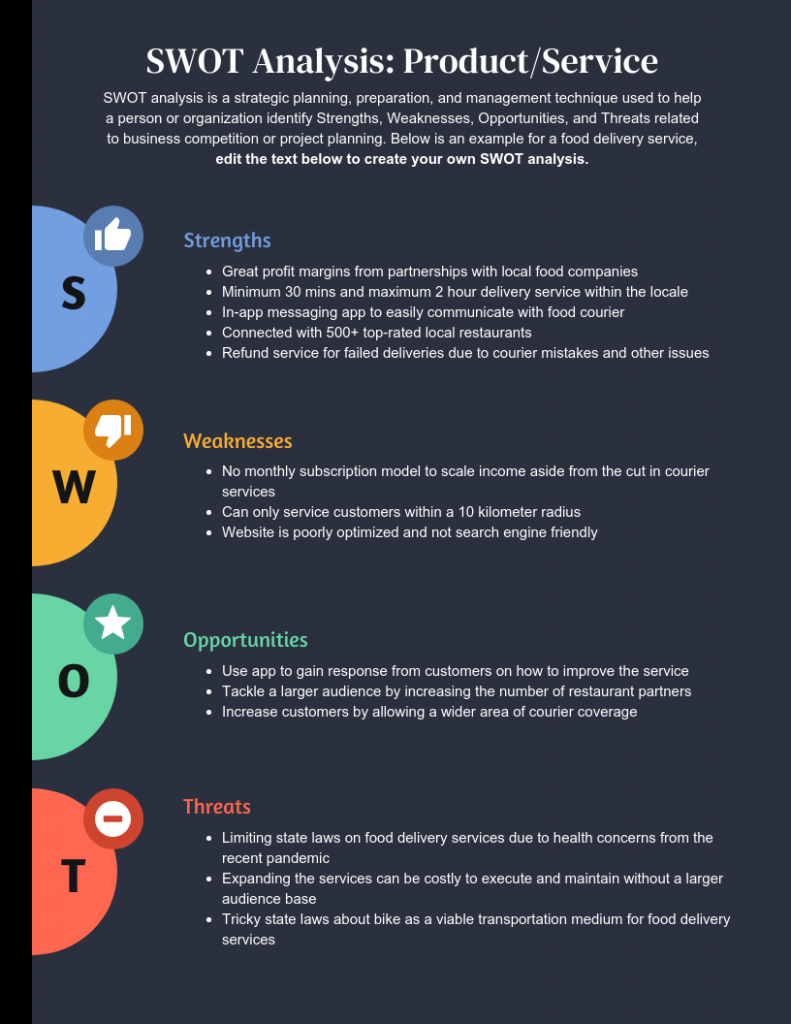
How to present a competitor analysis
Presenting a competitor analysis effectively involves organizing and communicating information about your competitors in a clear and concise manner. Here’s a step-by-step guide on how to present a competitor analysis:
- Introduction: Start with a brief introduction to set the stage. Outline the purpose of the competitor analysis and its significance in the current market context.
- Competitor identification: Clearly list and identify the main competitors. Include both direct and indirect competitors. Briefly describe each competitor’s core business and market presence.
- Key metrics and performance: Present key metrics and performance indicators for each competitor. This may include market share, revenue, growth rate, and any other relevant quantitative data.
- SWOT analysis: Conduct a concise SWOT analysis for each competitor. Summarize their strengths, weaknesses, opportunities, and threats. Use a simple visual representation if possible.
- Market positioning: Discuss how each competitor is positioned in the market. This could include their target audience, unique selling propositions, and any specific market niches they occupy. Also, focus on finding keywords , as your competitor’s targeted keywords are the main source of information on their online market performance.
- Strategic moves: Highlight recent strategic moves made by your competitors. This could include product launches, partnerships, mergers, acquisitions, or changes in pricing strategy. Discuss how these moves impact the competitive landscape.
- Recommendations and implications: Based on the analysis, provide recommendations and implications for your company. Identify opportunities to capitalize on competitors’ weaknesses and outline potential threats that need to be addressed. Discuss any adjustments to your own strategy that may be necessary in response to the competitive landscape.
3 tips to improve your competitive analysis report design
How you design your competitive analysis report can have a significant impact on your business success. The right report design can inspire stakeholders to take action based on your findings, while a mediocre design may reflect poorly on your hard work.
Here are a few report design best practices to keep in mind when designing your competitive analysis report:
- Start with a competitive analysis report template
- Keep core design elements like colors and fonts consistent
- Use visuals to summarize important information and keep your audience engaged
1. Start with a competitor analysis template
The quickest way to lose the confidence of your stakeholders is to present a messy, amateur report design. Besides distracting from the content of the report, it might even put your credibility at risk.
Starting with a pre-designed competitor analysis template, like the one below, takes almost all of the design work out of the mix so you can focus on the content (while still impressing your stakeholders).
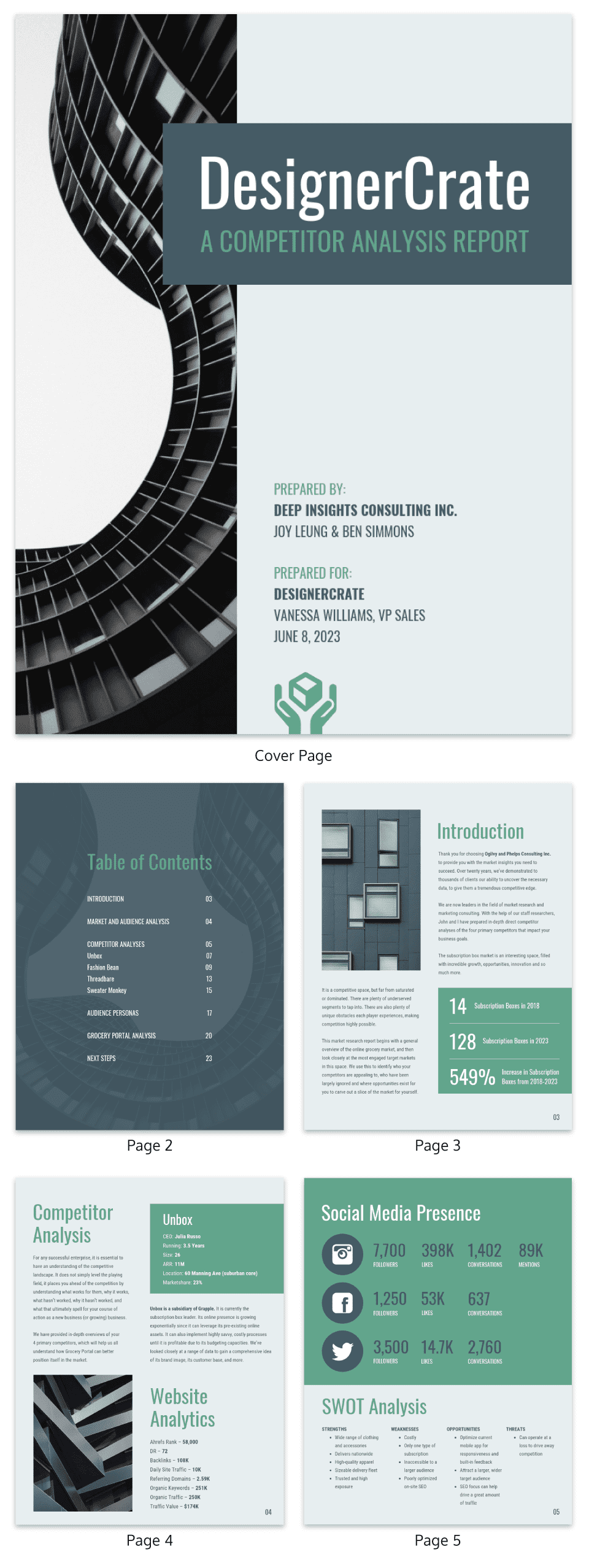
And if you’re a consultant competing for a project, a pre-designed template may just give you the edge you need to land that client.
Click on any of our templates; you’ll enter our online drag and drop report maker tool. No design know-how required.
2. Keep core design elements like colors and fonts consistent
If you take a look at the competitor analysis template below, you might notice that the designer has switched up the layout from page to page, but many of the other design elements are kept consistent.
That consistency helps the report design feel cohesive while making it easier for readers to quickly skim for key pieces of information.
Here are a few quick guidelines for keeping important design elements consistent:
- Use the same color scheme throughout your report (with one highlight color to draw attention to key takeaways and important numbers)
- Use the same font styles for your headers, subheaders, and body text (with no more than 2-3 font styles per report)
- Use the same style of visuals throughout your report (like flat icons or illustrated icons… but not both)
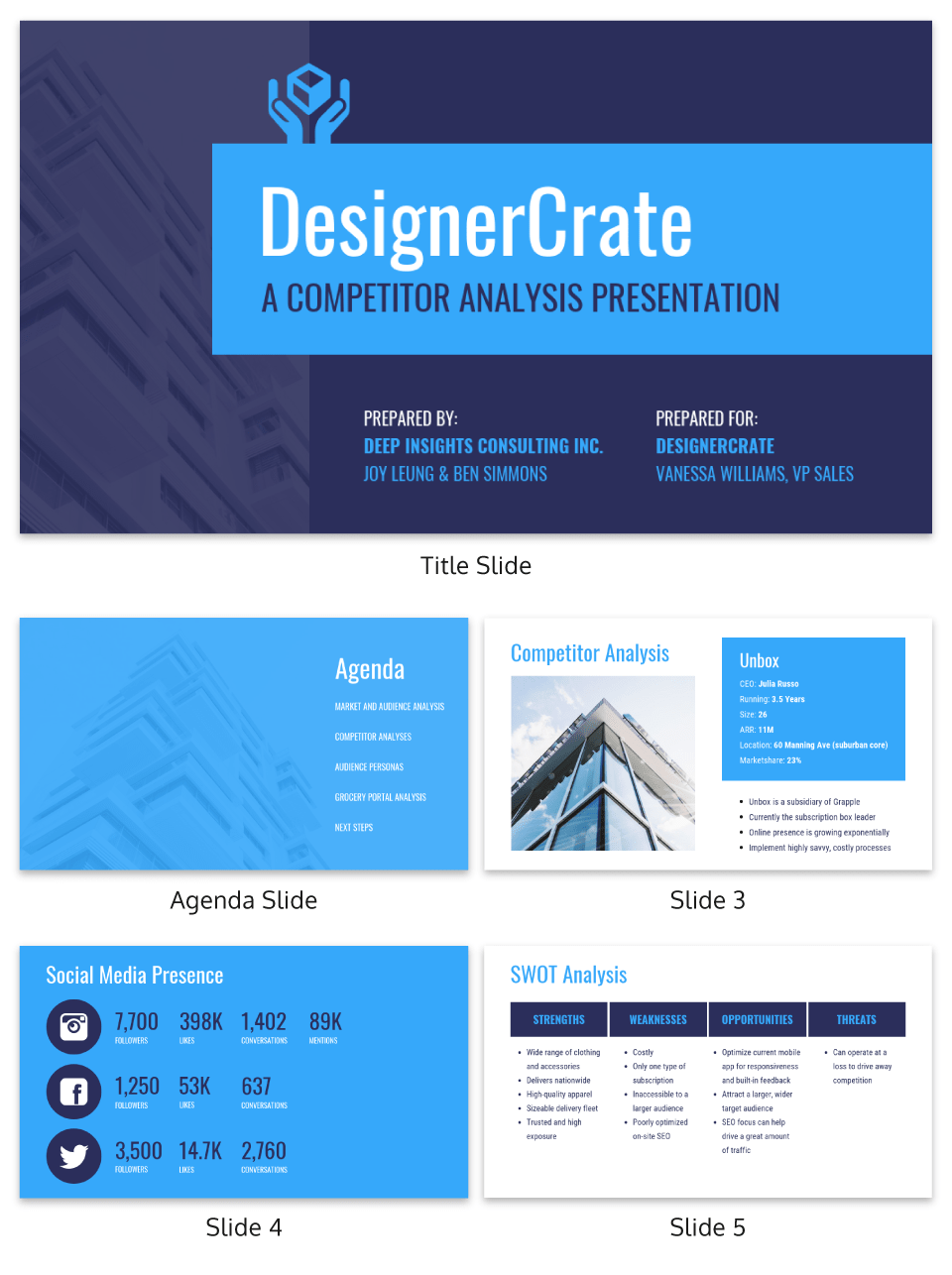
3. Use visuals to summarize important information and keep your audience engaged
The challenge with a competitive analysis report is that you collect heaps of background research, and you have to condense it into a brief report that your client will actually read.
And written summaries will only get you so far.
Visuals like charts and tables are a much better way to communicate a lot of research quickly and concisely, as seen in the market research summary below.
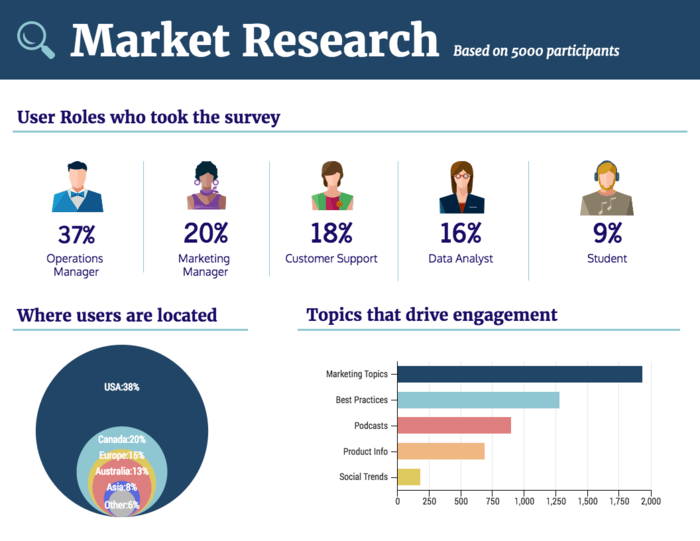
Even lists can be made more engaging and informative by spacing out list items and giving more emphasis to headers:
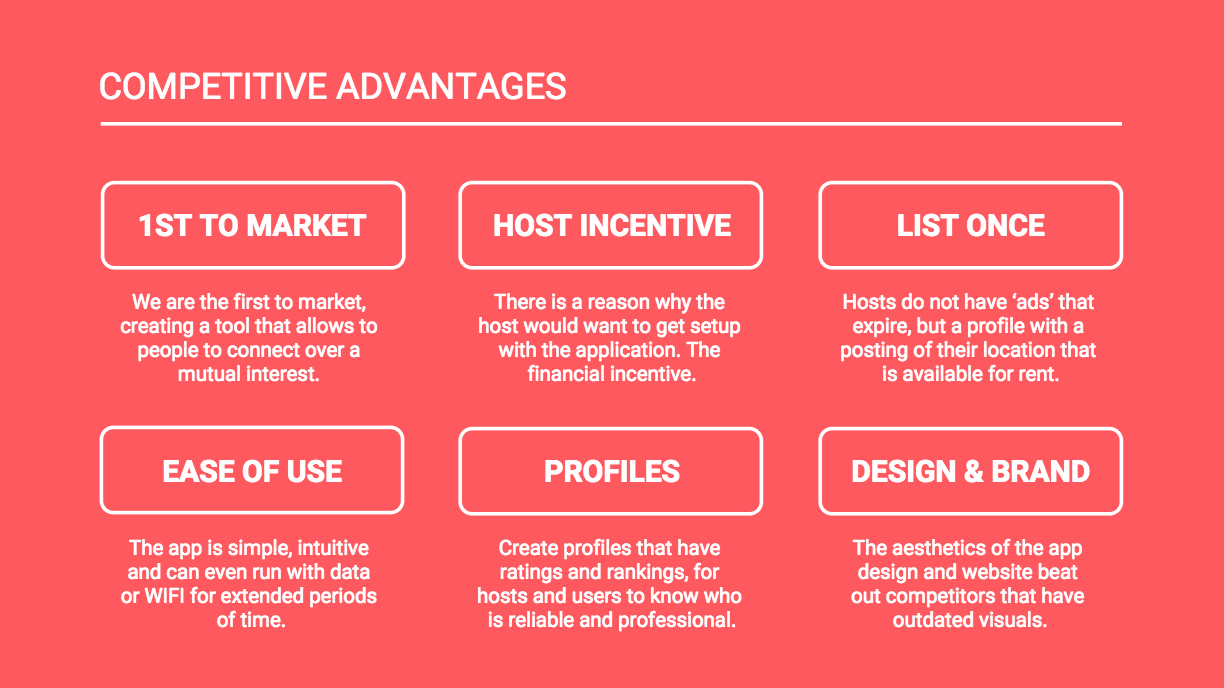
The more you can replace descriptive paragraphs and long lists with thoughtful visuals, the more your readers will thank you.
A competitive analysis will allow you to think up effective strategies to battle your competition and establish yourself in your target market.
And a report that communicates the findings of your competitive analysis will ensure stakeholders are on board and in the know.
Now that you know how to design a competitive analysis report, you’re ready to get started:
.css-s5s6ko{margin-right:42px;color:#F5F4F3;}@media (max-width: 1120px){.css-s5s6ko{margin-right:12px;}} Join us: Learn how to build a trusted AI strategy to support your company's intelligent transformation, featuring Forrester .css-1ixh9fn{display:inline-block;}@media (max-width: 480px){.css-1ixh9fn{display:block;margin-top:12px;}} .css-1uaoevr-heading-6{font-size:14px;line-height:24px;font-weight:500;-webkit-text-decoration:underline;text-decoration:underline;color:#F5F4F3;}.css-1uaoevr-heading-6:hover{color:#F5F4F3;} .css-ora5nu-heading-6{display:-webkit-box;display:-webkit-flex;display:-ms-flexbox;display:flex;-webkit-align-items:center;-webkit-box-align:center;-ms-flex-align:center;align-items:center;-webkit-box-pack:start;-ms-flex-pack:start;-webkit-justify-content:flex-start;justify-content:flex-start;color:#0D0E10;-webkit-transition:all 0.3s;transition:all 0.3s;position:relative;font-size:16px;line-height:28px;padding:0;font-size:14px;line-height:24px;font-weight:500;-webkit-text-decoration:underline;text-decoration:underline;color:#F5F4F3;}.css-ora5nu-heading-6:hover{border-bottom:0;color:#CD4848;}.css-ora5nu-heading-6:hover path{fill:#CD4848;}.css-ora5nu-heading-6:hover div{border-color:#CD4848;}.css-ora5nu-heading-6:hover div:before{border-left-color:#CD4848;}.css-ora5nu-heading-6:active{border-bottom:0;background-color:#EBE8E8;color:#0D0E10;}.css-ora5nu-heading-6:active path{fill:#0D0E10;}.css-ora5nu-heading-6:active div{border-color:#0D0E10;}.css-ora5nu-heading-6:active div:before{border-left-color:#0D0E10;}.css-ora5nu-heading-6:hover{color:#F5F4F3;} Register now .css-1k6cidy{width:11px;height:11px;margin-left:8px;}.css-1k6cidy path{fill:currentColor;}
- Project planning |
- How to create a competitive analysis (w ...
How to create a competitive analysis (with examples)

Competitive analysis involves identifying your direct and indirect competitors using research to reveal their strengths and weaknesses in relation to your own. In this guide, we’ll outline how to do a competitive analysis and explain how you can use this marketing strategy to improve your business.
Whether you’re running a business or playing in a football game, understanding your competition is crucial for success. While you may not be scoring touchdowns in the office, your goal is to score business deals with clients or win customers with your products. The method of preparation for athletes and business owners is similar—once you understand your strengths and weaknesses versus your competitors’, you can level up.
What is a competitive analysis?
Competitive analysis involves identifying your direct and indirect competitors using research to reveal their strengths and weaknesses in relation to your own.
![how to make a competitor analysis presentation [inline illustration] What is a competitive analysis (infographic)](https://assets.asana.biz/transform/c1a37dfd-53a8-44c4-b57b-10fc6a332ba1/inline-project-planning-competitive-analysis-example-1-2x?io=transform:fill,width:2560&format=webp)
Direct competitors market the same product to the same audience as you, while indirect competitors market the same product to a different audience. After identifying your competitors, you can use the information you gather to see where you stand in the market landscape.
What to include in a competitive analysis
The purpose of this type of analysis is to get a competitive advantage in the market and improve your business strategy. Without a competitive analysis, it’s difficult to know what others are doing to win clients or customers in your target market. A competitive analysis report may include:
A description of your company’s target market
Details about your product or service versus the competitors’
Current and projected market share, sales, and revenues
Pricing comparison
Marketing and social media strategy analysis
Differences in customer ratings
You’ll compare each detail of your product or service versus the competition to assess strategy efficacy. By comparing success metrics across companies, you can make data-driven decisions.
How to do a competitive analysis
Follow these five steps to create your competitive analysis report and get a broad view of where you fit in the market. This process can help you analyze a handful of competitors at one time and better approach your target customers.
1. Create a competitor overview
In step one, select between five and 10 competitors to compare against your company. The competitors you choose should have similar product or service offerings and a similar business model to you. You should also choose a mix of both direct and indirect competitors so you can see how new markets might affect your company. Choosing both startup and seasoned competitors will further diversify your analysis.
Tip: To find competitors in your industry, use Google or Amazon to search for your product or service. The top results that emerge are likely your competitors. If you’re a startup or you serve a niche market, you may need to dive deeper into the rankings to find your direct competitors.
2. Conduct market research
Once you know the competitors you want to analyze, you’ll begin in-depth market research. This will be a mixture of primary and secondary research. Primary research comes directly from customers or the product itself, while secondary research is information that’s already compiled. Then, keep track of the data you collect in a user research template .
Primary market research may include:
Purchasing competitors’ products or services
Interviewing customers
Conducting online surveys of customers
Holding in-person focus groups
Secondary market research may include:
Examining competitors’ websites
Assessing the current economic situation
Identifying technological developments
Reading company records
Tip: Search engine analysis tools like Ahrefs and SEMrush can help you examine competitors’ websites and obtain crucial SEO information such as the keywords they’re targeting, the number of backlinks they have, and the overall health of their website.
3. Compare product features
The next step in your analysis involves a comparison of your product to your competitors’ products. This comparison should break down the products feature by feature. While every product has its own unique features, most products will likely include:
Service offered
Age of audience served
Number of features
Style and design
Ease of use
Type and number of warranties
Customer support offered
Product quality
Tip: If your features table gets too long, abbreviate this step by listing the features you believe are of most importance to your analysis. Important features may include cost, product benefits, and ease of use.
4. Compare product marketing
The next step in your analysis will look similar to the one before, except you’ll compare the marketing efforts of your competitors instead of the product features. Unlike the product features matrix you created, you’ll need to go deeper to unveil each company’s marketing plan .
Areas you’ll want to analyze include:
Social media
Website copy
Press releases
Product copy
As you analyze the above, ask questions to dig deeper into each company’s marketing strategies. The questions you should ask will vary by industry, but may include:
What story are they trying to tell?
What value do they bring to their customers?
What’s their company mission?
What’s their brand voice?
Tip: You can identify your competitors’ target demographic in this step by referencing their customer base, either from their website or from testimonials. This information can help you build customer personas. When you can picture who your competitor actively targets, you can better understand their marketing tactics.
5. Use a SWOT analysis
Competitive intelligence will make up a significant part of your competitor analysis framework, but once you’ve gathered your information, you can turn the focus back to your company. A SWOT analysis helps you identify your company’s strengths and weaknesses. It also helps turn weaknesses into opportunities and assess threats you face based on your competition.
During a SWOT analysis, ask yourself:
What do we do well?
What could we improve?
Are there market gaps in our services?
What new market trends are on the horizon?
Tip: Your research from the previous steps in the competitive analysis will help you answer these questions and fill in your SWOT analysis. You can visually present your findings in a SWOT matrix, which is a four-box chart divided by category.
6. Identify your place in the market landscape
The last step in your competitive analysis is to understand where you stand in the market landscape. To do this, you’ll create a graph with an X and Y axis. The two axes should represent the most important factors for being competitive in your market.
For example, the X-axis may represent customer satisfaction, while the Y-axis may represent presence in the market. You’ll then plot each competitor on the graph according to their (x,y) coordinates. You’ll also plot your company on this chart, which will give you an idea of where you stand in relation to your competitors.
This graph is included for informational purposes and does not represent Asana’s market landscape or any specific industry’s market landscape.
![how to make a competitor analysis presentation [inline illustration] Identify your place in the market landscape (infographic)](https://assets.asana.biz/transform/fb2a8437-bb5e-4f0c-b5d0-91d67116bebe/inline-project-planning-competitive-analysis-example-2-2x?io=transform:fill,width:2560&format=webp)
Tip: In this example, you’ll see three companies that have a greater market presence and greater customer satisfaction than yours, while two companies have a similar market presence but higher customer satisfaction. This data should jumpstart the problem-solving process because you now know which competitors are the biggest threats and you can see where you fall short.
Competitive analysis example
Imagine you work at a marketing startup that provides SEO for dentists, which is a niche industry and only has a few competitors. You decide to conduct a market analysis for your business. To do so, you would:
Step 1: Use Google to compile a list of your competitors.
Steps 2, 3, and 4: Use your competitors’ websites, as well as SEO analysis tools like Ahrefs, to deep-dive into the service offerings and marketing strategies of each company.
Step 5: Focusing back on your own company, you conduct a SWOT analysis to assess your own strategic goals and get a visual of your strengths and weaknesses.
Step 6: Finally, you create a graph of the market landscape and conclude that there are two companies beating your company in customer satisfaction and market presence.
After compiling this information into a table like the one below, you consider a unique strategy. To beat out your competitors, you can use localization. Instead of marketing to dentists nationwide like your competitors are doing, you decide to focus your marketing strategy on one region, state, or city. Once you’ve become the known SEO company for dentists in that city, you’ll branch out.
![how to make a competitor analysis presentation [inline illustration] Competitive analysis framework (example)](https://assets.asana.biz/transform/56c32354-f525-4610-9250-f878ea0b9f26/inline-project-planning-competitive-analysis-example-3-2x?io=transform:fill,width:2560&format=webp)
You won’t know what conclusions you can draw from your competitive analysis until you do the work and see the results. Whether you decide on a new pricing strategy, a way to level up your marketing, or a revamp of your product, understanding your competition can provide significant insight.
Drawbacks of competitive analysis
There are some drawbacks to competitive analysis you should consider before moving forward with your report. While these drawbacks are minor, understanding them can make you an even better manager or business owner.
Don’t forget to take action
You don’t just want to gather the information from your competitive analysis—you also want to take action on that information. The data itself will only show you where you fit into the market landscape. The key to competitive analysis is using it to problem solve and improve your company’s strategic plan .
Be wary of confirmation bias
Confirmation bias means interpreting information based on the beliefs you already hold. This is bad because it can cause you to hold on to false beliefs. To avoid bias, you should rely on all the data available to back up your decisions. In the example above, the business owner may believe they’re the best in the SEO dental market at social media. Because of this belief, when they do market research for social media, they may only collect enough information to confirm their own bias—even if their competitors are statistically better at social media. However, if they were to rely on all the data available, they could eliminate this bias.
Update your analysis regularly
A competitive analysis report represents a snapshot of the market landscape as it currently stands. This report can help you gain enough information to make changes to your company, but you shouldn’t refer to the document again unless you update the information regularly. Market trends are always changing, and although it’s tedious to update your report, doing so will ensure you get accurate insight into your competitors at all times.
Boost your marketing strategy with competitive analysis
Learning your competitors’ strengths and weaknesses will make you a better marketer. If you don’t know the competition you’re up against, you can’t beat them. Using competitive analysis can boost your marketing strategy and allow you to capture your target audience faster.
Competitive analysis must lead to action, which means following up on your findings with clear business goals and a strong business plan. Once you do your competitive analysis, you can use the templates below to put your plan into action.
Related resources

Unmanaged business goals don’t work. Here’s what does.

How Asana uses work management to drive product development

How Asana uses work management to streamline project intake processes

How Asana uses work management for smoother creative production
Competitive Analysis Report Template
The better you understand your competitors, the better chance you have of standing out against them. How do you evaluate your competitors? By using a competitive analysis report.
A competitive analysis report template can help you identify competitors in your field, as well as analyze their reach, products or services, areas of operation, online presence, and more. Once you understand your competitors’ strengths and weaknesses, you can create strategies that help you bridge the gaps.
Use our competitive analysis report template to:
- Analyze your organization’s target market
- Compare your products or services against competitors
- Create future strategies to build stronger market share
Create a Competitive Analysis Report Template
Use every slide in your competitive analysis report to achieve your goal. Graphics can help illustrate the points you make in your presentation. Pictographs, line graphs, word clouds, Gantt charts, and sales funnels can be added to your competitive analysis report template with just one click. Here is a breakdown of the slides that we used in our competitive analysis report example:

Pro Tips for Building a Competitor Analysis Report Template
Follow these simple tips when customizing your competitor analysis report template.
Provide an overview of your competitors’ revenue, company size, reach, and customer perception. It’ll give your audience an idea of what your organization is up against.
Share buyer personas and industry trends to give your competitive analysis report the proper context.
Make your comparisons and evaluations visually engaging by using the right graphics in your presentation.
Based on your competitive analysis, what are the next steps your company should take? End your presentation with a succinct conclusion and call to action.
More Popular Templates

Tinder Pitch Deck
Valued at over $3 billion, dating app Tinder is one of the most popular apps today. Check out our makeover of the original Tinder pitch deck.

Sales Projection Presentation Template
Plan and manage your sales team initiatives in one place. Try the sales plan template.

Quarterly Project Update Template
A quarterly project update presentation is crucial for team collaboration and progress. Nail project management with our quarterly project update presentation template.

Dropbox Pitch Deck
You’ve likely used DropBox for saving and sharing files, but 13 years ago MIT students Drew Houston and Arash Ferdowsi were just hoping for a little funding to get their start-up off the ground. The initial pitch deck landed them their $1.2M seed round in 2007, though it left room for improvement. We recreated it in Beautiful.ai.


Marketing Campaign Plan Template
Our templates help marketers quickly showcase creative campaigns, media plans, and forecasting/performance reports to cover all the key areas needed from beginning to end of the marketing process to ensure all stakeholders are up to speed.

Usability Testing Presentation Template
Learn how Beautiful.ai’s usability testing template can help you gauge your customers and their use cases to better improve your product or service.
Competitor review presentation: A comprehensive guide
This presentation will help you understand your competitors' strengths and weaknesses, and develop a strategy to differentiate your business.
Raja Bothra
Building presentations

Hey there, savvy presenter!
Are you ready to dive into the world of competitor review presentations and take your business strategy to the next level?
If you want to stay ahead of the game, you've come to the right place.
In this comprehensive guide, we'll explore the art of crafting killer competitor reviews that not only impress but also drive results.
What is a competitor review?
Let's kick things off by understanding what a competitor review is all about. A competitor review, also known as competitive analysis, is the process of evaluating your rivals in the business arena. It involves analyzing their strengths, weaknesses, opportunities, and threats to gain a strategic advantage.
Benefits of competitor review presentation
Why should you bother with competitor reviews, you ask?
Well, they come with a host of benefits, and we're not just talking about staying one step ahead of your rivals. A well-executed competitor review can help you:
1. Boost your competitive edge : Uncover what makes your competitors tick and leverage that knowledge to outshine them.
2. Identify market trends : Stay in the loop with the latest market trends and adapt your strategy accordingly.
3. Enhance product quality : Learn from the successes and failures of others to improve your own products or services.
4. Fine-tune marketing strategies : Discover what works and what doesn't in your industry, saving you time and resources.
How to conduct a competitor review
Now that you're sold on the benefits, let's roll up our sleeves and get into the nitty-gritty of conducting a competitor review. Here are the steps to get you started:
- Gather data : Start by collecting information on your competitors, such as their products, pricing, and market presence.
- SWOT analysis : Conduct a SWOT analysis to identify strengths, weaknesses, opportunities, and threats.
- Market share analysis : Dive into market share data to understand your position in the industry.
- Competitive landscape : Visualize the competitive landscape with graphs and charts.
- Competitive intelligence : Harness the power of competitive intelligence to make informed decisions.
KPIs and metrics to add in competitor review presentation
To create a compelling competitor review presentation, you need to focus on the right Key Performance Indicators (KPIs) and metrics. Here's what you should consider:
- Market share : Assess your share of the market compared to competitors.
- Competitive advantage : Highlight what sets you apart from the competition.
- Position in the market : Understand your market position and how it's changing.
- Success factors : Identify the key factors contributing to your competitors' success.
How to structure an effective competitor review presentation
Now, let's delve into the structure of your competitor review presentation. Effectively structuring it is crucial to ensure your insights are conveyed clearly and captivate your audience. Here's a comprehensive breakdown:
1. Introduction: Begin with a captivating introduction that immediately grabs your audience's attention and sets the stage for your presentation. Clearly state the purpose of your presentation and why understanding your competitors is vital.
2. Background: Provide a concise overview of your industry and the market in which your business operates. Identify your primary competitors and explain the criteria for their selection, ensuring transparency in your methodology.
3. Competitor Analysis: For every competitor, furnish a detailed overview that encompasses:
- Company history and mission : Explore the background and objectives that drive your competitors.
- Target market : Define the audience they cater to and how they engage with them.
- Products and services : Present a comprehensive list of their offerings.
- Strengths and weaknesses : Objectively evaluate their strong suits and areas where they lag behind.
- Pricing : Discuss their pricing strategies and how they compare to yours.
- Marketing strategy : Examine how they promote their products or services.
Utilize impactful visuals like charts, graphs, and tables to bolster your analysis, making it easier for your audience to grasp the information.
4. SWOT Analysis: Conduct a SWOT analysis for your own company to identify its strengths, weaknesses, opportunities, and threats. This self-assessment is crucial for benchmarking against your competitors. Compare your SWOT analysis to those of your competitors to pinpoint areas where you hold a competitive advantage or face challenges.
5. Conclusion: Summarize the key findings from your competitor review and distill them into actionable recommendations. Reiterate the significance of comprehending your competitors in the marketplace. Conclude your presentation with a compelling call to action, such as inviting questions or encouraging further exploration of your company.
To craft an effective competitor review presentation, consider these additional pointers:
- Prioritize clarity and conciseness. Ensure that your audience can grasp your main points without delving into every detail on your slides.
- Leverage visuals judiciously. Visual aids can enhance engagement and facilitate understanding.
- Maintain objectivity. Maintain neutrality in your assessments, avoiding negative or personal comments about competitors.
- Focus on essential information. Don't overwhelm your audience with an excessive amount of data. Concentrate on the key takeaways you want them to remember.
- Practice your delivery. Rehearse your presentation beforehand to convey it confidently and smoothly.
By adhering to these guidelines, you can craft a compelling competitor review presentation that not only informs but also captivates your audience.
Do's and don'ts on a competitor review presentation
As you gear up to create your competitor review presentation, keep these do's and don'ts in mind:
Do's :
- Incorporate charts and graphs to make complex data digestible.
- Keep it concise and to the point. Less is often more.
- Infuse humor naturally if it fits the tone of your presentation.
Don'ts :
- Don't overwhelm your audience with excessive data. Stick to the essentials.
- Avoid jargon and complex terminology. Keep it simple and relatable.
Summarizing key takeaways
In a nutshell, creating a top-notch competitor review presentation is all about gathering the right data, analyzing it effectively, and presenting it in a compelling way. Remember, you're not just presenting data; you're telling a story that guides your business strategy.
We've covered the ins and outs of competitor review presentations. You've learned the importance of conducting competitor reviews, how to structure them effectively, and the do's and don'ts to keep in mind. Armed with this knowledge, you're ready to conquer the business world one presentation at a time. Good luck, and may your presentations always impress and inform!
1. What is a competitor review presentation, and how does it differ from a traditional powerpoint presentation?
A Competitor Review Presentation, often referred to as an analysis PowerPoint, goes beyond a standard PowerPoint presentation ppt. It includes competitor analysis templates, editable slides, and analysis reports. It's designed to help you perform a competitor analysis effectively.
2. How can I use a competitor analysis powerpoint template to enhance my presentation?
Competitor analysis powerpoint ppt templates are pre-designed sets of powerpoint presentation slides with names like; competitive analysis powerpoint templates, competitor analysis report, competitor ppt, etc. They cover various stages in the analysis process, contain editable powerpoint and google slides. You can use these templates to create impressive analysis powerpoint presentations and stand out from the crowd.
3. Can I download competitor analysis powerpoint slides in PDF and JPG formats for sharing?
Yes, you can download powerpoint presentations, including competitive analysis report slides, are easily convertible into PDF and JPG formats thru trusted websites. Simply click the download button, and you'll have your content as per your preferred format, ready to share with your audience.
4. How can a competitor review orientation help my business succeed?
A competitor review presentation, with the right graphics and analysis, can help your business in many ways. It enables you to identify strategies that help your business stand out from the crowd. It's an essential tool for making informed decisions and staying ahead of your competitors.
5. What stages are covered in a competitor analysis presentation, and what topics are discussed in these slides?
You can see competitor analysis presentation covers multiple stages, such as the competitor analysis framework, competitor comparison, and competitor profiling. The topics discussed in these slides vary from product analysis to business strategies that help you outperform your competitors. These presentation templates are available for immediate download and come in various layouts, including four-stage and eight-stage processes.
Create your competitor review presentation with Prezent
Ready to take the plunge and create a competitor review presentation that wows your audience? Look no further than Prezent! With our vast library of presentation slides, templates, and analysis tools, you'll be well-equipped to outshine your competition.
So, what are you waiting for? Start crafting your competitor review presentation today and position your business for success.
Sign up for our free trial or book a demo !
Get the latest from Prezent community
Join thousands of subscribers who receive our best practices on communication, storytelling, presentation design, and more. New tips weekly. (No spam, we promise!)

MarketingSherpa Blog

- Letters to the Editor
- Sponsorships
- Web Design Services
- MarketingSherpa.com

How to Write a Competitive Analysis (with 3 free templates)
“It’s not enough that we win; all others must lose.” – Larry Ellison
Personally, I disagree with Larry, and I think that the focus should be on the customer winning. Hopefully that’s often through your product or service offering, but sometimes your competitors can serve customers looking for a solution better than you can. In those cases, I think all parties (your company, your competitor and your customer) are better served by acknowledging that.
In fairness, Larry Ellison is the fifth richest man in the world, so if that’s how you keep score, he has much more credibility than I. On the other hand, he was paraphrasing Genghis Khan with his quote, so I guess it all depends whom you want to emulate with your marketing.
Learning from the competition
But, whether you agree with Larry or me (or even Genghis), I’m sure that we can all see the value in better understanding what competitors are doing.
So you can conduct a competitive analysis for the obvious reasons — to bludgeon the competition and raze their villages. However, you can also conduct a competitive analysis to help you better communicate with your customers about how you can best serve them (and even tell them what you can’t do ) while perhaps honing the fine art of “coopetition.”
Moreover, a competitive analysis is an especially helpful tool to help you craft your value proposition .
Free competitive analysis templates
To help you conduct a competitive analysis, we’ve created a few free templates loosely based on the Summary Competitive Analyses we conduct for our own Research Partners here at MECLABS .
Competitive analysis presentation
For a slight deeper dive, you can use this PowerPoint template.
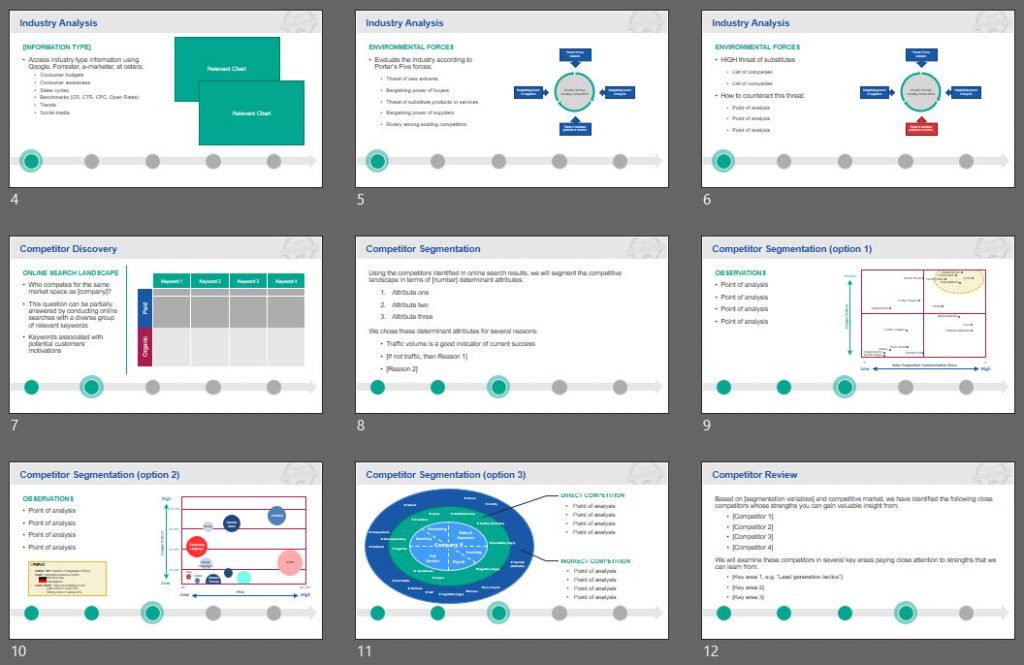
Download the MECLABS Competitive Analysis Presentation Template
Competitive analysis Excel template
For a more in-depth look at your competitive landscape, this competitive analysis Excel template might be helpful to you.
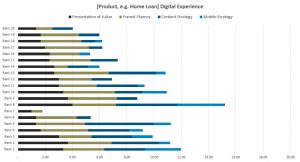
Download the MECLABS Competitive Analysis Template
Download the MECLABS Competitive Analysis Template (Excel 97-2003 Version)
Very simple competitive analysis
If you’re only looking to get a very simple breakdown about your competitive landscape, you can use this simple Word document.
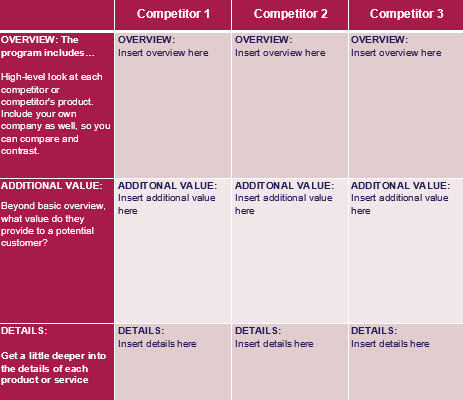
Download the MECLABS Very Simple Competitive Analysis Template
Even better, you can use these documents to communicate at three levels. While the fields aren’t the same in all of them, the PowerPoint and Word templates are meant to be a summary of the Excel template. So, you can use the Excel template to guide your own competitive analysis, the PowerPoint template to present this analysis to key marketing leaders, and the Word document as a memo to senior business leaders who would be less interested in all of the details.
Getting started
Digital marketing makes conducting a competitive analysis easier than it has ever been. While in the past, your best opportunity might have been to dive into the SEC filings of a public company, and perhaps sign up for their mailing list and buy some data from a business information vendor, now much of the information you need to know is publicly available … even metrics.
You can use social media and product review sites to see what customers think of your competitors, as well as obtain some real metrics on how many followers they have. You can also use sites like SimilarWeb and Alexa to get a very rough (and let me emphasize, very rough) look at the traffic numbers and patterns for your competitors’ sites.
And, don’t overlook the power of search …
“Start the competitive analysis as if you were a potential customer and a run couple of searches with your popular keywords or using keywords that search engines recommend,” said Ana Gabriela Paez, Associate Director of Research, MECLABS.
“Then analyze companies that appear on paid and natural search results. You may not get all of your possible competitors, but you will get those that are working hard to steal traffic from your site. Sometimes companies will focus too much on reviewing their traditional competitors and forget to frequently monitor search results to see if there are new competitors in the mix or potential new substitutes for your product or service.”
That last point Gaby makes is crucial. After all, your competitors aren’t who you think they are, your competitors are who your customers think they are. So, if your goal is to make the best horse-drawn carriage and that is your only focus, you’ll never see that automobile coming.
And, perhaps most importantly, don’t overlook your own efforts. A competitive analysis is of little practical use if you don’t look at your own products and marketing materials with the same inquisitive eye, and then place your findings side by side with your competitors, stand shoulder to shoulder and see how you match up.
And, while you’re standing next to them, if you follow the teachings of Larry Ellison and Genghis Khan, give them a good, hard kick in the shin.
Related Resources
Gather Competitive Intelligence: 5 Tactics to Research Your Marketplace
Prospect Marketing: Nurturing leads lost to competitors
Competitive Messaging: Tell your customers what you can’t do
Online Reviews: How to start discovering your value proposition with Yelp
About Daniel Burstein
Daniel Burstein, Senior Director of Editorial Content, MECLABS. Daniel oversees all content and marketing coming from the MarketingExperiments and MarketingSherpa brands while helping to shape the editorial direction for MECLABS – digging for actionable information while serving as an advocate for the audience. Daniel is also a speaker and moderator at live events and on webinars. Previously, he was the main writer powering MarketingExperiments publishing engine – from Web clinics to Research Journals to the blog. Prior to joining the team, Daniel was Vice President of MindPulse Communications – a boutique communications consultancy specializing in IT clients such as IBM, VMware, and BEA Systems. Daniel has 18 years of experience in copywriting, editing, internal communications, sales enablement and field marketing communications.
Twitter | LinkedIn | Daniel's Posts | Send a Letter to the Editor
Categories: Research And Measurement Tags: competitive analysis , competitive messaging , free tools , Value Proposition
Excel template is composed of xml files and there is no xls document in it.
Am I doing something wrong?

Hi @Ugur Ongor ,
We uploaded the original file, which was created as a .xlsx. If you have an older version of Excel, then you might would have some issues. We have now added the template in a .xls file as well, but there may be some functionality lost with the version differences. I hope this helps.
Let me know if there’s something I else I can do to help.
Great post Daniel. Do you have an email address you could send me to get in touch with you? Thanks, Jason

Jason, You can reach me at Editor AT MarketingSherpa DOT com
Ellison once told his sales force that Oracle’s competitive objective was to “cut off their oxygen,” but the quote you attribute to him was stolen from Gore Vidal (“It is not enough to succeed. Others must fail.”) who said it in the late 1970s.
I have learn several excellent stuff here. Certainly value bookmarking for revisiting. I wonder how so much effort you place to make such a magnificent informative web site.
Very good templates. Any suggestions for technical evaluations of industrial software products? And specially B2B products?
I like these templates very interesting. Please update me with the current ones.
The templates are a fantastic help! Any suggestions or participants occupying the Mobile and or Application Development space?
Thanks for these – very helpful. Do you have any thoughts on the usefulness of a visual competitive mapping vs a more linear competitive analysis? When do you think you should use each one?
Great article!
I think those templates are really good to get a start. But I think competitive intelligence in year 2015 includes a new strong component of monitoring marketing. This necessity comes along with the explosion f marketing channels in the digital world. Its really crucial to keep track of successful campaigns of the competition and to understand what is working within the target audience.
Thanks for reading and commenting Oleksandr. I agree, a competitive analysis isn’t a one-and-done activity. The marketplace is always changing. For example, anyone who conducted an analysis of the grocery marketplace a few months ago would probably be well served by understanding how recent developments change their competitive position in the marketplace.
Peter, I’m a big believer in properly attributing a quote, so thanks for questioning the source.
Based on your comment, I did some further digging, and found this article on Quote Investigator (a website sourced by The New York Times, The Washington Post, and many other publications): http://quoteinvestigator.com/2012/08/06/succeed-fail/
According to the article, the first usage of a pretty similarly phrased idea was in 1959 by Somerset Maugham. Gore Vidal didn’t actually say it (he said the similar “Every time a friend succeeds I die a little.” but in an article by Wilfrid Sheed in The New York Times about Vidal, he uses the similarly phrased idea and credits it to La Rochefoucauld.
And then in 1988 Larry Ellison said, “It is not sufficient that I succeed – all others must fail” and crediting his paraphrase of the quote to Genghis Khan.
While this seems like it’s an authoritative source, I’m not 100% sure if is exactly accurate. I think the big picture is that, while many have had this idea through history, whether the idea started with Genghis Khan, La Rochefoucauld or Somerset Maugham, this is roughly the way Larry Ellison used to subscribe Oracle’s competitive stance.
While I disagree with the extreme nature of this sentiment, I do agree that it is important to keep an eye on your competition. After all, your value proposition is relative to other value propositions in the marketplace and dynamically changes as your competitors’ value propositions change as well.
Top Resources
Infographic: how to create a model of your customer’s mind.

Infographic: 21 Psychological Elements that Power Effective Web Design

7 Steps to Discovering Your Essential Value Proposition with Simple A/B Tests

Marketer Vs Machine

Free Marketing Course

- Affiliate Marketing
- B To B Ecommerce
- Business Technology Marketing
- Business To Business
- Channel Marketing
- Lead Generation
- Sales Lead Generation
- B2C Marketing
- Consumer Electronics
- Consumer Packaged Goods
- Ecommerce Eretail
- Entertainment And Sports Marketing
- Financial Services Marketing
- Health Marketing
- Real Estate Marketing
- Retail And Restaurant
- Travel And Hospitality Marketing
- Content Marketing
- Copywriting
- Customer-Centric Marketing
- Email Marketing
- Event Marketing
- Inbound Marketing
- International Marketing
- Marketing and Advertising
- Marketing Careers
- Marketing Law
- Media Buying
- Non Profit Fundraising
- Offline Marketing And Advertising
- Online Advertising
- Online Marketing
- PR Fame Communications
- Referral Marketing
- Research And Measurement
- Search Marketing
- Social Media Marketing
- Social Media
- Uncategorized
- Value Proposition
- Video Marketing
- Viral Marketing
- Website And Landing Page Design
Advisory boards aren’t only for executives. Join the LogRocket Content Advisory Board today →

- Product Management
- Solve User-Reported Issues
- Find Issues Faster
- Optimize Conversion and Adoption
What is competitive analysis? Template, examples, and how-to

In this comprehensive guide, we’ll define what a competitive analysis is, describe the benefits product teams stand to gain from conducting one, and walk through the steps of how to do a competitive analysis.

Through the tutorial, we’ll refer to examples to demonstrate how each step of a competitive analysis works in practice. We’ll also provide a list of customizable, free competitive analysis templates for you to use when completing these steps on your own.
Complete guide to competitive analysis
Picture this: you just came up with the next disruptive, game changing, AI-powered e-commerce marketplace. The objective is to connect buyers with sellers to fulfill their tailored and customized product needs.
You’re confident your product will take on Etsy and other big players in the market. You did some market and user research and have a good idea of your ideal customer and their (underserved) needs. Based on this data, you believe your marketplace can reach product-market fit quickly.
It’s now time for you to dust off your copy of Sun Tzu’s T he Art of War . Why is that, you ask?
The Art of War is an ancient Chinese military textbook that, although dated somewhere between ~500–400 B.C., is one of the most influential management books out there to this day. It provides great strategic and tactical advice. Moreover, it provides guidance to help you assess yourself and your competition to gain an advantage.
Maintaining a competitive advantage is the goal. Even if you have the best product in the world and you know there is a market for it, if you don’t understand your competition, you‘re bound to fail. That’s why you need to perform a competitive analysis.
As the band Rage Against the Machine would say, know your enemy .
What is competitive analysis?
Competitive analysis (sometimes called a competitor analysis or competition analysis) is exactly what it sounds like: a structured approach to identifying and analyzing your competitors. More concretely, it’s an assessment of your competition’s offerings, strategy, strengths, and weaknesses.
A competitive analysis helps you answer questions such as:
- Which other companies are providing a solution similar to ours?
- What are the ideal customer’s minimum expectations?
- What are they currently not getting from our product with regard to those expectations?
- What barriers do competitors in the market fce?
- What should we avoid introducing in our product?
- What price are customers willing to pay for our product?
- What value do we need to provide to make our product stand out in the market?
- What trends are happening and how might they change the playing field?
When conducted thoroughly and regularly, a competitive analysis provides you with tons of information that can be used to improve and optimize your product. The end result is a holistic overview of your competitor landscape.
Why do a competitive analysis?
Competitive analysis is a fundamental product management instrument. It helps PMs learn what works and what doesn’t when trying to acquire market share, identify market trends, and locate gaps in their product offering.
Competitive analysis exists to help you avoid making mistakes and empower you to beat competitors to the punch in the pursuit of product growth and success.
Knowing your competition will bring you great rewards. Conducting a competitive analysis will help you more effectively:
- Create benchmarks
- Identify opportunities to better serve customers
- Make strategic decisions
- Determine your pricing strategy
- Identify market gaps
- Determine distribution and marketing strategies
Typically, the first time you create a competitor analysis is when doing your market research. This helps you get an idea of the product-market fit , which will evolve along your journey.
As a product manager, your role is not to analyze how well your competitors are able to showcase themselves. It is your job to make the product what the customer needs it to be. Understanding your competitor’s capabilities, pricing, and product positioning helps you in this.
Keep in mind that your competitors will likely showcase themselves to appear better than they probably are. You’ll be able to acquire tons of information about them, but you should take that information with a pinch of salt.
How to do a competitive analysis
There is no a single way to do a competitive analysis. In general, a competitive analysis is made up of three fundamental components:
- A shortlist of competitors
- A competitor deep dive
- A holistic overview and strategy
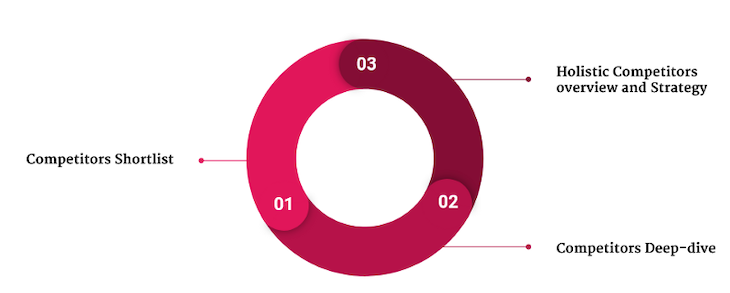
To demonstrate how to do a competitor analysis, we’ll refer back to the example outlined in the introduction.

Over 200k developers and product managers use LogRocket to create better digital experiences
Remember, in our example, we’re looking to disrupt the market with an AI-powered e-commerce marketplace app that helps buyers and sellers connect to fulfill highly customized orders. Let’s call our innovative new product AGORA.
1. Create a shortlist of your competitors

There are three types of competitors:
- Direct — Competitors that offer the same product and target the same ideal customer; you are battling direct competitors heads-on
- Indirect — Competitors that either offer a somewhat similar product or target the same ideal customer
- Replacement — Competitors that offer a different product but target the same ideal customer
For a competitive analysis, you need to identify at least your direct and indirect competitors. So how do you do that? By looking inward and researching obsessively .
Look inward
To figure out who your direct and indirect competitors are, you need to look inward first to understand your product positioning: who are you servicing and what is the offering you are providing?
You can answer these questions by doing a self-assessment using the product canvas . Originally introduced by Roman Pichler, the product canvas has since tbeen tweaked and refined.
In its core, the product canvas covers:
- The name of the product
- Objectives and key metrics for success
- The ideal customer
- A high-level overview of what’s required to meet the customer’s needs
- Just enough product details about short-term goals
For our example product, the competitive analysis might look something like this:

Research obsessively
A simple Google search using keywords from your self-assessment can get you pretty far. Other resources that can help you identify your competitors include tools such as Crunchbase, Similarweb, Statista, etc.
As the old saying goes, the customer knows best. If you don’t have many customers yet, review sites such G2, Capterra, Trustpilot, and Google Reviews can help you.
If you do have customers, go ask them. Most customers try and evaluate several products before deciding on the right product to buy. Nothing is stopping you from asking them which other brands they considered and why they ultimately chose yours.
Once you have established who your competitors are, you might find yourself in a market with many direct and indirect competitors. If that is the case, select about seven of the most relevant competitors to include in your competitor deep dive.
2. Do a deep dive on each competitor
From your a shortlist of competitors, choose about seven of your most important and dig up all the relevant information on each one.
The research conducted during the previous step will help you capture the most relevant information about your competitors for the following categories:
Company profile
Ideal customer profile, product information, market approach, swot analysis.
Start by creating a company profile for each of your competitors to gain a better understanding of who they are. Include the following information:
- Name — What is the name of your competitor?
- Founding date — When was the company founded? How long has it been in the market?
- Company size — How many employees does the company have? Are they equipped to service the market and innovate?
- Market share — The portion of the market controlled by the competitor’s product
- Revenue — The income the competitor generates from its product
- Reputation — What do customers think of your competitor’s product on a scale from one to five?
Let’s apply this framework to our AGORA competitive analysis example:
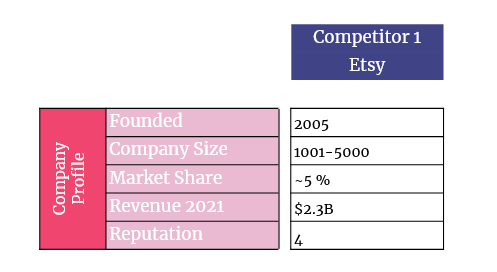
It’s important to understand who your competitors are serving and who is buying the product. This not only to reconfirm that the competitor is indeed a direct (or indirect) competitor, but also to understand what customers like and dislike about the competitor’s product.
The information you’re looking for includes:
- Ideal customer — Who is the competitor’s target customer and what defines them?
- Motivations — What does the customer enjoy about your competitor’s product?
- Frustrations — What does the customer hate about the product?
- Primary buyer — Who is the primary buyer of the product? Is it the as the ideal customer, or is it a different persona?
Let’s see what this would look like following our AGORA example. Below is an example ideal customer profile for Etsy. First, for the buyer:
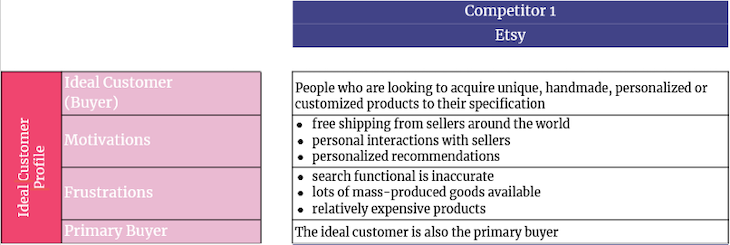
And the ideal customer profile for Etsy sellers:

Not to be captain obvious, but you want to capture more details about the product your competitor is offering and its positioning.
The information we’re looking for at this step includes:
- The product — What is the tagline your competitor is using to market its product?
- Positioning — Based on the quality and price of the product, place the product into a one of several buckets. For example, Economy (low quality, low price), Skimming (low quality, high price), Penetration (high quality, low price), and Premium (high quality, high price)
- Product features — What are the key features being marketed and promoted?
Referring to our example AGORA app, the product information associated with Etsy on a competitor analysis might look as follows:
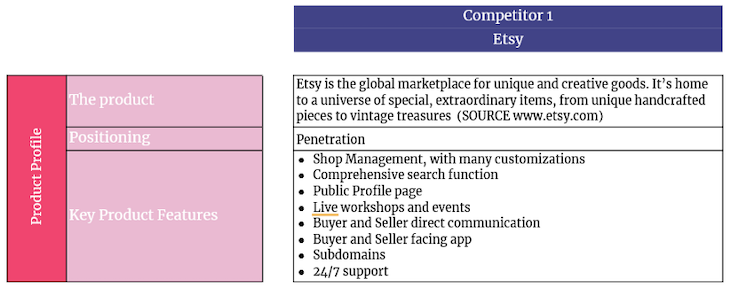
Next, seek to understand how your competitors are bringing the product to market .
List the following information:
- Pricing — What does the product costs? If there is a tiered pricing model, what does it look like?
- Distribution channels — Through which channels is your competitor selling the product?
- Marketing channels — Through which channels is the product being promoted?
In our AGORA competitor analysis example, this section would look something like:
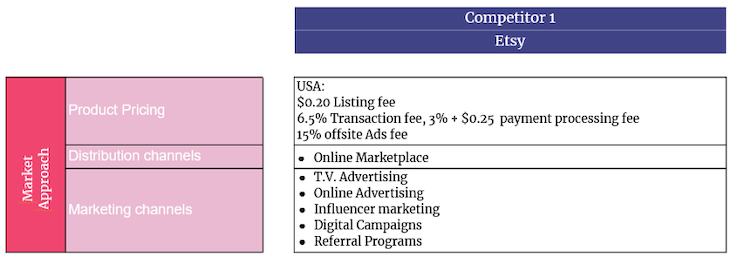
With all the information you’ve collected, you’ll find yourself in a good place to do a SWOT analysis . This is one of the most common and popular competitive analysis frameworks.
SWOT stands for strengths, weaknesses, opportunities, and threats:
- Strengths — What is going well for the competitor?
- Weaknesses — What is not going well? What obvious flaws are there?
- Opportunities — What could give your competitor an advantage?
- Threats — What might harm your competitor’s product?
For AGORA, our example competitive analysis might include a SWOT analysis that looks like this:
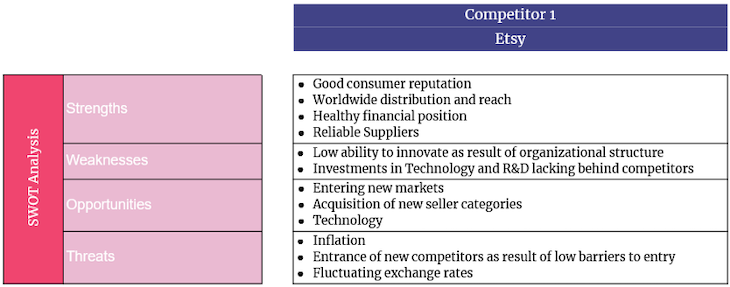
3. Develop a holistic overview and strategy
Now that you have a better view of your competitors, it’s time to determine how you want to approach them in the market: do you want to avoid your competitors or attack them?
Two extremely useful tools that can help you make this assessment are the competitive matrix and battle cards .
Competitive matrix
One way to operationalize the data you gathered during your competitive analysis is to plot out a four-quadrant competitive matrix.
Define key factors for the and x and y axes and plot yourself and your competition accordingly to see how you stack up. This approach is also known as perceptual mapping.
A competitive matrix for our example would look like this:
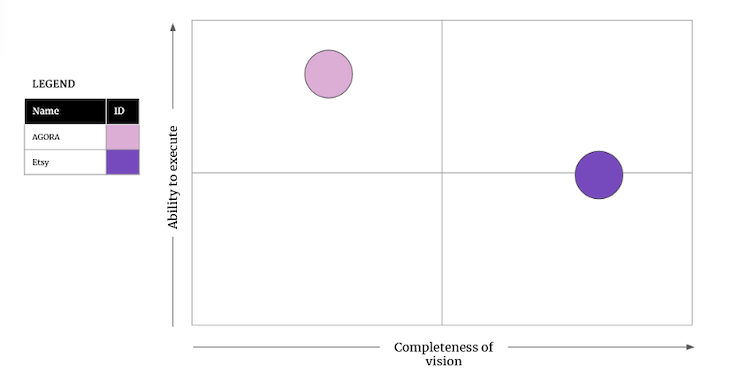
Battle cards
You can use the four-quadrant competitive matrix and competitor insights to create battle cards for each of your competitors.
Battle cards are a visual aid that help you compare your product against those of your competitors at a glance. It’s a quick and easy way to see how you stack up in key areas of performance and value. It’s also a neat way to help sales in their conversations with customers.
Here’s what you should include on each battle card:
- Company name — Name of your competitor
- Powers — What makes this competitor stand out from the rest?
- How we win — What should we do to gain a competitive advantage over this competitor?
- Why we lose — What is this competitor better at? What should we avoid so we don’t lose market share?
- Pricing — How much of a threat is the competitor’s product to our market share (low, medium, or high)?
- Strategy — Should we attack or avoid this competitor?
A battle card for our example competitive analysis might look as follows:
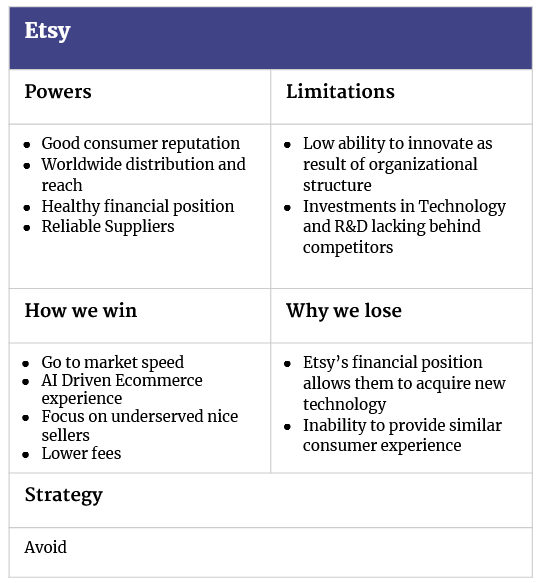
Alternative competitive analysis frameworks
If you‘ve followed the framework described above, you should have solid insight into your competitors, your product opportunities, and the best strategy to attack or avoid your competitors in the market.
If you want to dig deeper, you can follow up your competitive analysis by producing a Five Forces analysis and/or customer journey map .
The Five Forces model
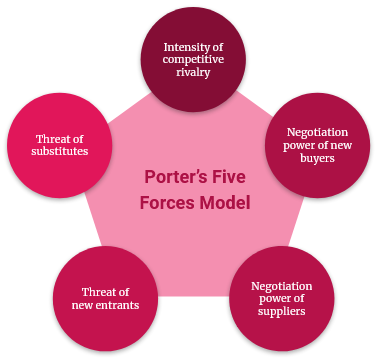
You still might want to consider gaining more insights into the competitive structure of the market you are in — in other words, gain a better understanding of how easy it is to either enter or be replaced by a competitor in the market.
A great framework to use for this type of competitor analysis is the Five Forces model , originally conceived by Michael Porter.
According to the Five Forces model, you can assess the market you are in by looking at:
- Intensity of competitive rivalry
- Negotiation power of new buyers
- Negotiation power of suppliers
- Threat of new entrants
- Threat of substitutes
Customer journey map
Instead of zooming out, you can also zoom in on the journey ideal customers make when interacting with the product itself, the distribution, or marketing channels.
On a journey map, your touchpoints are the customer, the activity performed, how the customer experiences the activities, and their expectations.
Free competitive analysis templates
A competitive analysis is a continuously updated document packed with information about your most important competitors to help you determine how to approach them in your target market.
The competitive analysis model described in this article consists of three steps that are designed to produce the insights you need to rule the market once and for all.
Below are free, customizable competitive analysis templates for each step of the process described in this article:
- Competitive analysis template
- Product canvas template
- Competitive matrix template
- Battle card template
- Customer journey map template
NOTE : To use and customize the competitive analysis templates above, after opening, select File > Make a copy from the main menu.
Featured image source: IconScout
LogRocket generates product insights that lead to meaningful action
Get your teams on the same page — try LogRocket today.
Share this:
- Click to share on Twitter (Opens in new window)
- Click to share on Reddit (Opens in new window)
- Click to share on LinkedIn (Opens in new window)
- Click to share on Facebook (Opens in new window)
- #market analysis

Stop guessing about your digital experience with LogRocket
Recent posts:.

Leader Spotlight: Growing the omnichannel market, with Christine Kuei
Christine Kuei, Director of Product Management at Forever 21, shares her experience growing and optimizing omnichannel experiences.

Decoding marketing jargon: A glossary of terms
The world of product marketing is always evolving. Even for experts, it can be hard to keep up with the latest concepts, terms, and jargon.
Leader Spotlight: Bettering learning velocity, with Jonas O. Klink
Jonas talks about his team’s initiatives to “better the learning velocity” — taking an initial idea through hypothesis-driven development to build customer-centric, scalable solutions.

Leader Spotlight: Energizing your leadership style, with Navya Rehani Gupta
Navya Rehani Gupta talks about her three main pointers for mastering the art of zooming in and zooming out.

Leave a Reply Cancel reply

- Business Slides
- Competitive Analysis
Powerpoint Templates
Icon Bundle
Kpi Dashboard
Professional
Business Plans
Swot Analysis
Gantt Chart
Business Proposal
Marketing Plan
- Project Management
Business Case
Business Model
Cyber Security
Business PPT
Digital Marketing
- Digital Transformation
Human Resources
Product Management
Artificial Intelligence
Company Profile
Acknowledgement PPT
PPT Presentation
Reports Brochures
One Page Pitch
Interview PPT
All Categories

Competitive Analysis PowerPoint Templates, Competitive Advantage PPT Templates
- Sub Categories
- 30 60 90 Day Plan
- About Us Company Details
- Action Plan
- Annual Report
- Audit Reports
- Balance Scorecard
- Brand Equity
- Business Case Study
- Business Communication Skills
- Business Plan Development
- Business Problem Solving
- Business Review
- Capital Budgeting
- Career Planning
- Change Management
- Color Palettes
- Communication Process
- Company Location
- Company Vision
- Corporate Governance
- Cost Reduction Strategies
- Custom Business Slides
- Customer Service
- Data Management
- Decision Making
- Digital Marketing Strategy
- Disaster Management
- Equity Investment
- Financial Analysis
- Financial Services
- Growth Hacking Strategy
- Human Resource Management
- Innovation Management
- Interview Process
- Knowledge Management
- Lean Manufacturing
- Legal Law Order
- Market Segmentation
- Media and Communication
- Meeting Planner
- Mergers and Acquisitions
- Operations and Logistics
- Organizational Structure
- Performance Management
- Pitch Decks
- Pricing Strategies
- Process Management
- Product Development
- Product Launch Ideas
- Product Portfolio
- Purchasing Process
- Quality Assurance
- Quotes and Testimonials
- Real Estate
- Risk Management
- Sales Performance Plan
- Sales Review
- Service Offering
- Social Media and Network
- Software Development
- Solution Architecture
- Stock Portfolio
- Strategic Management
- Strategic Planning
- Supply Chain Management
- System Architecture
- Team Introduction
- Testing and Validation
- Time Management
- Timelines Roadmaps
- Value Chain Analysis
- Value Stream Mapping
- Workplace Ethic
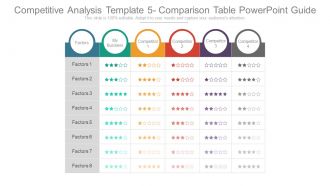
Presenting competitive analysis template 5 comparison table powerpoint guide. This is a competitive analysis template 5 comparison table powerpoint guide. This is a five stage process. The stages in this process are factors, my business, competitor.
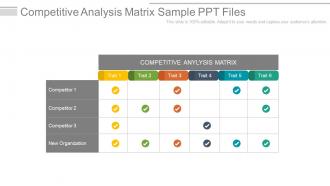
As these slides have been made in PowerPoint using the most basic diagrams you can easily customize all the shapes, illustrations and figures. You can change the color, size and positioning of any text anywhere. If wish to add or delete text present in the PPT template or if you wish to make any changes in the design of the table, there are pictured stepwise instructions in the sample slides that you can follow and make the required changes. You can easily save these slides in JPG or PDF format. These business templates are also compatible with Google Slides so they are very easy to use.

Presenting Competitive Analysis PowerPoint Presentation Slides. Image quality will not alter if when you resize the image. Easy editing with color, text and fonts. This presentation is fully compatible with Google slides. PowerPoint slide with text placeholders to add business details. Change the presentation design into JPG and PDF formats. Helpful for corporate users and business entrepreneurs and managers.

These are fully editable PowerPoint slides. Can be easily downloaded. These templates contain 51 slides. Easily convertible into PDF and JPG formats. Professionally created presentation designs. Easily compatible with Google Slides.The stages in this process are competitive analysis report, marketing strategies, branding strategy, positioning strategy, distribution strategy, promotion strategy, marketing plan, marketing management.
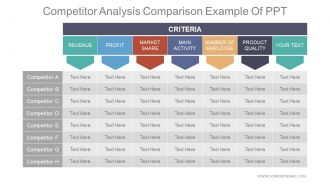
Presenting competitor analysis comparison example of ppt. This is a competitor analysis comparison example of ppt. This is a seven stage process. The stages in this process are profit, revenue, market share, main activity, number of employee, product quality, criteria.

These presentation slides are 100% editable. Quickly downloadable slides. These templates consist of 52 slides. High-resolution template designs. These slides are totally risk-free. Compatible presentation layout. Our PPT graphics can be easily converted to PDF and JPG formats. These slides can be shown in standard and widescreen.The stages in this process are competitive intelligence analysis and strategy, branding strategy, positioning, strategy, distribution strategy, promotion strategy, marketing plan, marketing management.

Easy proofing and change in characteristic features can be done in presentation visual. Presentation slide is useful for business owners, stakeholders marketing, other concerned parties, and management. Professional layout and theme in which font, color and layout can be altered. Interesting color scheme gives an executive look to PPT layout. Conversion into PDF or JPG formats is trouble free and uncomplicated. PPT graphic aids font size that can be read from some distance. Shapes, graphs, tables and charts can be checked as per requirement.
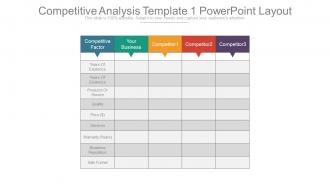
Presenting competitive analysis template 1 powerpoint layout. This is a competitive analysis template 1 powerpoint layout. This is a five stage process. The stages in this process are competitive factor, your business, competitor, years of existence, years of existence, products or service, quality, price, services, warranty, business reputation, sale funnel.

Promptly comparable and downloadable PPT slides, very appropriate for business experts from assorted fields or zones. Editable content, text style, foundation and PowerPoint Image. Easily convertible into PDF or JPG groups. Can be utilized with Google slides and on other programming stages. Space choice with the presentation slide graphs to embed the titles or captions as required. Likewise offers the adjustable group of variable symbols which can be altered by size and shading.
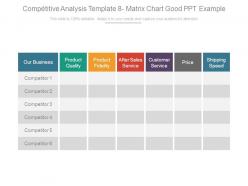
Presenting competitive analysis template 8 matrix chart good PPT example slide. This layout is Compatible with Google slides. Easy to put in company logo, trademark or name; accommodate words to support the key points. Images do no blur out even when they are projected on large screen.PPT template can be utilized by sales and marketing teams and business managers. Instantly downloadable slide and supports formats like JPEG and PDF. Adjust colors, text and fonts as per your business requirements.
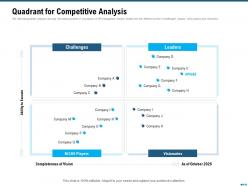
The following quadrant analyzes and map the relative position of key players of API Management Market, divided into four different section of challengers, leaders, niche players and visionaries. Increase audience engagement and knowledge by dispensing information using Market Outlook Of API Management Quadrant For Competitive Analysis Ppt Portfolio Template. This template helps you present information on four stages. You can also present information on Challenges, Leaders, Visionaries, Quadrant for Competitive Analysis using this PPT design. This layout is completely editable so personaize it now to meet your audiences expectations.
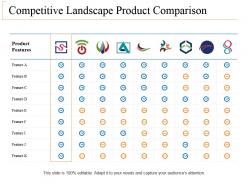
Presenting competitive landscape product comparison powerpoint slide designs. This is a competitive landscape product comparison powerpoint slide designs. This is a eight stage process. The stages in this process are competitive analysis, competitive landscape, competition.

This PPT slide can be used by professionals for competitive landscape, competitive analysis, competitive intelligence analysis techniques related PowerPoint presentations. This PowerPoint template can be personalized by all means which includes text, color, and size. The patterns of the given portions can be reconstructed according to your liking and you can choose icons among the abundance of options available. These slides are also smoothly congenial with Google slides.

This PPT slide maintains in delivering a gratifying and elite experience to the customers. It can be picked by managers/team leaders for an uncompromising experience in competitive landscape modeling, competitive analysis model, porters five forces model, and strategic planning analysis related PPT presentations. The color schemes, icons, text boxes in the slides can easily be altered according to your liking. This PPT slide is available in full screen version, is editable and compatible with Google slides.
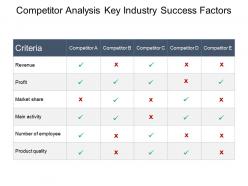
Presenting, competitor analysis key industry success factors PPT slide design. You can easily alter the text by editing it in PowerPoint software and include your company logo or trademark. This PowerPoint template is a modern way to represent performance and time management concept of your organization. This slide works smoothly in all software and is free of space constraints to mention titles and subtitles. Use it in fullscreen mode after downloading. We have shown a high-quality design which does not deteriorate in quality when edited or projected on a widescreen. Download this PowerPoint deck in a snap and explore full features.
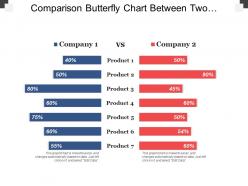
Presenting this set of slides with name - Comparison Butterfly Chart Between Two Companies And Products. This is a two stage process. The stages in this process are Differentiation, Comparison, Compare.

Presenting this set of slides with name - Competitor Analysis Framework Powerpoint Presentation Slides. This is a one stage process. The stages in this process are Competitor Landscape Framework, Competitor Analysis Framework, Competitor Landscape Model.

This powerpoint slide can be used by professionals from diverse business backgrounds for representing their competitor intelligence analysis related PowerPoint slides. You can switch the images used here and can easily edit the text area to compose a brief about your strategic planning and conclusions. Run these PPT slides with google slides and project on full screens without pixelation.
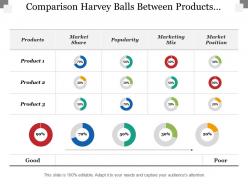
Presenting this set of slides with name - Comparison Harvey Balls Between Products Market Share Popularity. This is a four stage process. The stages in this process are Differentiation, Comparison, Compare.

Reshaping of charts, graphs and tables is easily manageable in PPT slide. Picture perfect and flawless functioning is ensured by the presentation slide show on all software. Coloring scheme, text size and position can be brought into line as per the requirement. When displayed on the broad screen the PPT layout does not lose on pixels or color resolution. Can be put to service by support department, HR, businessmen, managers and other professionals to keep a track of competitors.
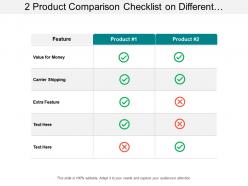
Presenting this set of slides with name - 2 Product Comparison Checklist On Different Features. This is a two stage process. The stages in this process are Product Comparison, Product Differentiation, Brand Differentiation.
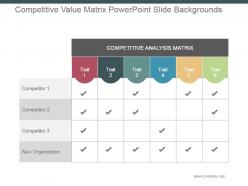
Presenting competitive value matrix powerpoint slide backgrounds. This is a competitive value matrix powerpoint slide backgrounds. This is a six stage process. The stages in this process are competitive analysis matrix, trait, competitor, new organization.
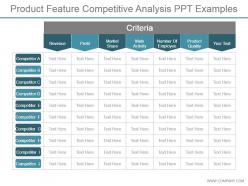
Presenting product feature competitive analysis ppt examples. This is a product feature competitive analysis ppt examples. This is a ten stage process. The stages in this process are criteria, revenue, profit, market share, main activity, number of employee, product quality, competitor.
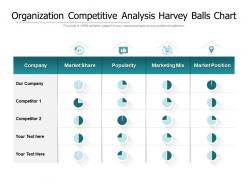
Presenting this set of slides with name Organization Competitive Analysis Harvey Balls Chart. The topics discussed in these slides are Company, Market Share, Popularity, Marketing Mix, Market Position. This is a completely editable PowerPoint presentation and is available for immediate download. Download now and impress your audience.
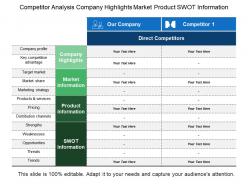
Presenting this set of slides with name - Competitor Analysis Company Highlights Market Product Swot Information. This is a two stage process. The stages in this process are Competitor Analysis, Competitor Landscape.

This aptly crafted editable PPT deck contains twelve slides. Our topic specific Competitor Analysis Market Positioning Product Development Business Strategy presentation deck helps devise the topic with a clear approach. We offer a wide range of custom made slides with all sorts of relevant charts and graphs, overviews, topics subtopics templates, and analysis templates. Speculate, discuss, design or demonstrate all the underlying aspects with zero difficulty. This deck also consists creative and professional looking slides of all sorts to achieve the target of a presentation effectively. You can present it individually or as a team working in any company organization.

Professionals can use these slides for their competitive analysis module and portray their ideas in a comprehensive manner. Personalization is ingenious after downloading, you can edit the text areas and color schemes, along with altering the icons and images used in the PPT bundle. These PowerPoint slides are also compatible with Google slides and are convertible to JPEG or PDF format.

Presenting this set of slides with name - Competitive Differentiators Powerpoint Presentation Slides. This complete deck can be used to present to your team. It has PPT slides on various topics highlighting all the core areas of your business needs. This complete deck focuses on Competitive Differentiators Powerpoint Presentation Slides and has professionally designed templates with suitable visuals and appropriate content. This deck consists of total of twenty two slides. All the slides are completely customizable for your convenience. You can change the colour, text and font size of these templates. You can add or delete the content if needed. Get access to this professionally designed complete presentation by clicking the download button below.
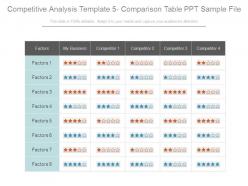
Presenting competitive analysis template 5 comparison table ppt sample file. This is a competitive analysis template 5 comparison table ppt sample file. This is a eight stage process. The stages in this process are factors, my business, competitor.
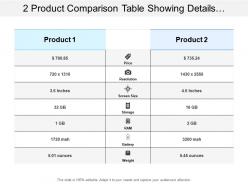
Presenting this set of slides with name - 2 Product Comparison Table Showing Details At Each Features. This is a two stage process. The stages in this process are Product Comparison, Product Differentiation, Brand Differentiation.

Use this PPT slide for the concept of competitive assessment module in your business projects. You can easily download this enticing PPT template and take authority of the full version of these slides which includes remodeling the text, changing the colors, icons, and images according to your liking. The watermarks are temporary, insert your company's logo and prepare slides in widescreen.

Presenting this set of slides with name - Competitive Differentiation Powerpoint Presentation Slides. This complete deck is oriented to make sure you do not lag in your presentations. Our creatively crafted slides come with apt research and planning. This exclusive deck with seventeen slides is here to help you to strategize, plan, analyse, or segment the topic with clear understanding and apprehension. Utilize ready to use presentation slides on Competitive Differentiation Powerpoint Presentation Slides with all sorts of editable templates, charts and graphs, overviews, analysis templates. It is usable for marking important decisions and covering critical issues. Display and present all possible kinds of underlying nuances, progress factors for an all inclusive presentation for the teams. This presentation deck can be used by all professionals, managers, individuals, internal external teams involved in any company organization.
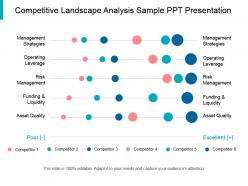
Presenting competitive landscape analysis sample ppt presentation. This is a competitive landscape analysis sample ppt presentation. This is a five stage process. The stages in this process are competitive analysis, competitive landscape, competition.
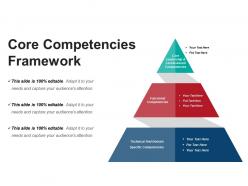
Presenting core competencies framework Powerpoint guide presentation which is completely editable. The PPT is used by business analysts, business managers etc. The PowerPoint presentation is compatible with multiple software and format options and with Google Slides also. Editing instructions are also provided for your kind assistance. The user can easily customize and personalize this slideshow as per his / her requirements. The visuals being of good quality do not pixelate when this PPT slide is projected on the wide screen.
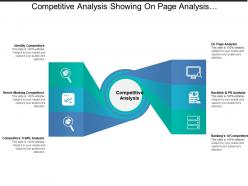
Introducing competitive analysis showing onpage analysis and competitor traffic analysis PPT layout. Preference to modify the content as per your business need. Adjustable as can be transformed into PDF or JPEG formats. Pre-designed presentation slide is easy to download and saves time. PowerPoint design can be shared with different nodes and stages. Swift download and easy to share with large set of viewers. Presentation template is accessible in standard and widescreen display.

Presenting this set of slides with name Competitive Analysis Chart With Bubbles. The topics discussed in these slides are Sales, Month, Competitor, Price Millions. This is a completely editable PowerPoint presentation and is available for immediate download. Download now and impress your audience.
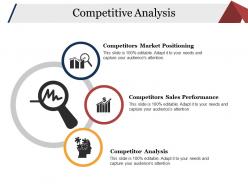
Presenting this set of slides with name - Competitive Analysis Powerpoint Slides. This is a three stage process. The stages in this process are Competitors Market Positioning, Competitors Sales Performance, Competitor Analysis.
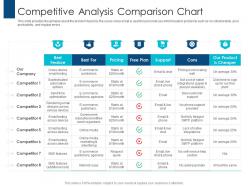
This slide provides the glimpse about the problem faced by the users since email is used for personal use which leads to problems such as no collaboration, poor productivity, and regular errors. Present the topic in a bit more detail with this Competitive Analysis Comparison Chart Pitching For Consulting Services Ppt Professional Aids. Use it as a tool for discussion and navigation on E Commerce, Advertising, Marketing, Media, Cost. This template is free to edit as deemed fit for your organization. Therefore download it now.
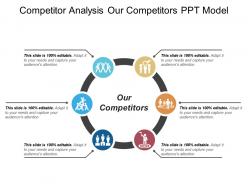
Presenting competitor analysis our competitors PPT mode PPT slide. Well crafted and professionally equipped PowerPoint visual. There is the use of bright and bold colors for maximum visual appeal. Ease of editing every component of the PPT template. Guidance for executing the changes has been provided for assistance. Modify and personalize the presentation by including the company name and logo. PPT is compatible with a varied number of format options and also compatible with multiple software options available both online and offline. Widely used by entrepreneurs, business strategists, business analysts, stakeholders, students, and teachers.
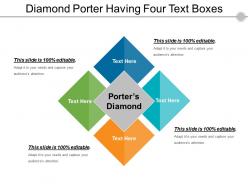
Presenting diamond porter having four text boxes. This is a diamond porter having four text boxes. This is a four stage process. The stages in this process are diamond porter, competitive advantage, competitive landscape.
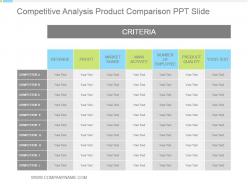
Presenting competitive analysis product comparison ppt slide. This is a competitive analysis product comparison ppt slide. This is a seven stage process. The stages in this process are revenue, profit, market share, main activity, number of employee, product quality.
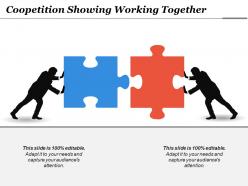
Presenting this set of slides with name - Coopetition Showing Working Together. This is a two stage process. The stages in this process are Co Opetition, Coopertition, Cooperative Competition.
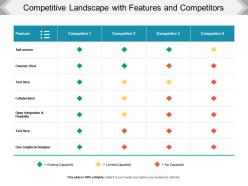
Presenting this set of slides with name - Competitive Landscape With Features And Competitors. This is a four stage process. The stages in this process are Business Swot Analysis, Product Comparison And Competitive Landscape, Competitive Analysis, Swot Analysis Competitor Comparison.
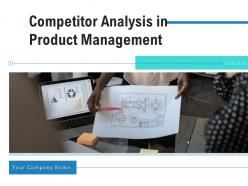
Presenting our competitor analysis in product management powerpoint presentation slides PowerPoint theme. This PPT layout has total of eighty-one slides and is accessible in standard as well as wide-screen formats. It is completely editable as per your preferences and needs as well. You can use it with Microsoft Office, Google slides and many other presentation software.

Deliver a credible and compelling presentation by deploying this Competitive Landscape Analysis Business Growth Products Assessment Deployment. Intensify your message with the right graphics, images, icons, etc. presented in this complete deck. This PPT template is a great starting point to convey your messages and build a good collaboration. The eleven slides added to this PowerPoint slideshow helps you present a thorough explanation of the topic. You can use it to study and present various kinds of information in the form of stats, figures, data charts, and many more. This Competitive Landscape Analysis Business Growth Products Assessment Deployment PPT slideshow is available for use in standard and widescreen aspects ratios. So, you can use it as per your convenience. Apart from this, it can be downloaded in PNG, JPG, and PDF formats, all completely editable and modifiable. The most profound feature of this PPT design is that it is fully compatible with Google Slides making it suitable for every industry and business domain.
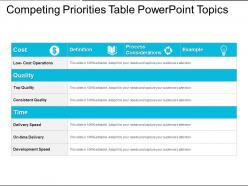
Presenting Competing Priorities Table PowerPoint Topics. It is a professionally designed PowerPoint template with relevant visuals and content. You can change the color, text, and font size as per your need. You can add or delete the content wherever required. This slide is available in both standard and widescreen size. Its compatibility with Google Slides makes it easily accessible. Convert and save this PPT slide in both PDF and JPG format.
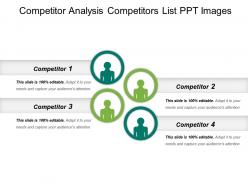
Presenting, competitor analysis competitor list PPT images slide. This PowerPoint template can be personalised by all means, which means text, color, and patterns of the given portions can be reconstructed according to your liking and you can choose icons among the abundance of options available. We have shown engaging color patterns and icons here to make this PPT design more interactive. These slides are also smoothly congenial with Google slides. Include your company data in this predesigned PPT format just by following a few simple steps. This PPT layout is available in both standard 4:3 and widescreen format 16:9 after downloading.
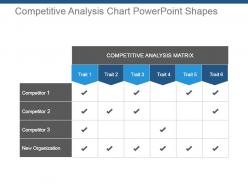
Presenting competitive analysis chart powerpoint shapes. This is a competitive analysis chart powerpoint shapes. This is a six stage process. The stages in this process are competitive analysis matrix, trait, new organization, competitor.
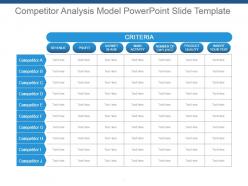
Presenting competitor analysis model powerpoint slide template. This is a competitor analysis model powerpoint slide template. This is a seven stage process. The stages in this process are revenue, profit, market share, main activity, number of employee, product quality, competitor.

Presenting a competitive analysis template PPT sample download PPT slide. PPT has impressive visuals of high quality. Good quality resolution. No issue of blurred images when projected on a wide screen. PPT is compatible with multiple numbers of online and offline software options. Ease of personalization and customization. Add the data and figures with ease. For assistance refer to the editing guidance provided in the presentation itself. Effectively downloaded and used by entrepreneurs, strategists, marketers, students, and teachers.

This complete deck comprises of Competitive Market Analysis Powerpoint Presentation Slides and has professionally designed templates with suitable visuals and appropriate content. This complete deck can be used to present to your team. It has PPT slides on various topics highlighting all the core areas of your business needs. This deck consists of total of fifty slides. All the slides are completely customizable for your convenience. You can change the colour, text and font size of these templates. You can add or delete the content if needed. Get access to this professionally designed complete presentation by clicking the download button below.
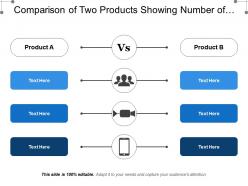
Presenting this set of slides with name - Comparison Of Two Products Showing Number Of Users. This is a two stage process. The stages in this process are Comparison Of Two, Compare, comeptitive analysis.
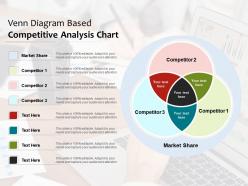
Presenting this set of slides with name Venn Diagram Based Competitive Analysis Chart. This is a three stage process. The stages in this process are Market Share, Competitor. This is a completely editable PowerPoint presentation and is available for immediate download. Download now and impress your audience.
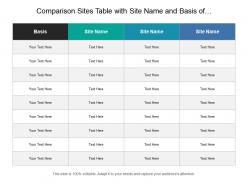
Presenting this set of slides with name - Comparison Sites Table With Site Name And Basis Of Comparison Three Columns. This is a three stage process. The stages in this process are Comparison Sites, Compare Sites, Competitor Sites.

Presenting Competing Priorities Layout PowerPoint Show. You can easily download this template to access its full version. This template allows you to resize it and make changes in the fonts, colors, images, icons as per your needs. This slide is compatible with Google Slides and other formats such as PDF, JPG, and PNG. The slide designs are available in both the designs- standard(4:3) and widescreen(16:9). The slide is made up of high-resolution graphics that do not infer the quality when viewed on widescreen.
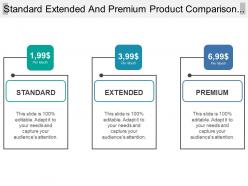
Presenting this set of slides with name - Standard Extended And Premium Product Comparison Chart. This is a three stage process. The stages in this process are Business Swot Analysis, Product Comparison And Competitive Landscape, Competitive Analysis, Swot Analysis Competitor Comparison.
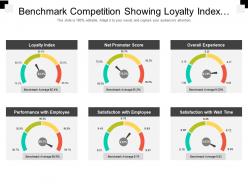
Presenting this set of slides with name - Benchmark Competition Showing Loyalty Index And Net Promoters Score. This is a six stage process. The stages in this process are Benchmark Competition, Competitive Analysis, Competition Landscape.
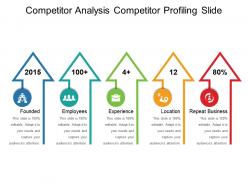
Presenting, competitor analysis competitor profiling slide PPT design templates. Include your company data in this predesigned PPT format just by following a few simple steps. This slide allows you to edit the subject head and another text area to anything that suits you according to your analysis. Include your company logo here in the PPT to personalize further. We have shown a high-quality design which does not deteriorate in quality when edited or projected on a widescreen. Change the icons shown to your liking. After downloading this PPT slide you can use it in the widescreen mode for a better experience.
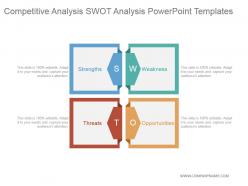
Presenting competitive analysis swot analysis powerpoint templates. This is a competitive analysis swot analysis powerpoint templates. This is a four stage process. The stages in this process are strengths, weakness, opportunities, threats.
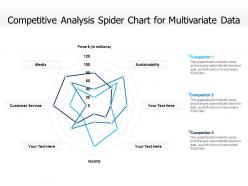
Presenting this set of slides with name Competitive Analysis Spider Chart For Multivariate Data. The topics discussed in these slides are Media, Customer Service, Price Millions, Sustainability, Quality, Competitor. This is a completely editable PowerPoint presentation and is available for immediate download. Download now and impress your audience.
Item 1 to 60 of 575 total items
- You're currently reading page 1


IMAGES
VIDEO
COMMENTS
Step 6: Document Your Research. In this last step, compile all your research in written format. Create an action plan that includes a tactical list of steps to take. This way, you can discuss and prioritize steps to take with your team. Aim to be concise as you create this competitor analysis document.
Here's a step-by-step guide on how to present a competitor analysis: Introduction: Start with a brief introduction to set the stage. Outline the purpose of the competitor analysis and its significance in the current market context. Competitor identification: Clearly list and identify the main competitors.
Competitor analysis is the process of evaluating your direct competitors' companies, products, and marketing strategies. To make your analysis truly useful, it's important to: Pick the right competitors to analyze. Know which aspects of your competitors' business are worth analyzing. Know where to look for the data.
Creating a competitor analysis presentation requires a structured approach. Follow these steps to conduct a thorough analysis: Identify your competitors: Begin by identifying your direct and indirect competitors. Gather data: Collect data on competitors' strengths, weaknesses, products, pricing, and market position.
You decide to conduct a market analysis for your business. To do so, you would: Step 1: Use Google to compile a list of your competitors. Steps 2, 3, and 4: Use your competitors' websites, as well as SEO analysis tools like Ahrefs, to deep-dive into the service offerings and marketing strategies of each company.
It allows you to set your target market, understand potential customers and their needs, and evaluate the competition in order to get an advantage over them. These market research and competitor analysis PowerPoint templates will help you convey all your findings to your team and build a strategic business plan accordingly.
Direct competitors are businesses that offer a similar solution to the same audience. They matter a lot more than indirect competitors (i.e. businesses with different products but targeting the same audience as you) because you'll be compared with them often (e.g. in product reviews and rankings).
Create a Competitive Analysis Report Template. Use every slide in your competitive analysis report to achieve your goal. Graphics can help illustrate the points you make in your presentation. Pictographs, line graphs, word clouds, Gantt charts, and sales funnels can be added to your competitive analysis report template with just one click.
Show off your data with thoughtful, simple displays. 2. Make it weird (as long as it's on-brand) Talking about your competitors is an opportunity to highlight what makes your brand different. If ...
A well-executed competitor review can help you: . 1. Boost your competitive edge: Uncover what makes your competitors tick and leverage that knowledge to outshine them. 2. Identify market trends: Stay in the loop with the latest market trends and adapt your strategy accordingly.
Free competitive analysis templates. To help you conduct a competitive analysis, we've created a few free templates loosely based on the Summary Competitive Analyses we conduct for our own Research Partners here at MECLABS. Competitive analysis presentation. For a slight deeper dive, you can use this PowerPoint template.
Competitive analysis exists to help you avoid making mistakes and empower you to beat competitors to the punch in the pursuit of product growth and success. Knowing your competition will bring you great rewards. Conducting a competitive analysis will help you more effectively: Create benchmarks.
How to Present a Competitor Analysis . Visualize Data Effectively : Utilize charts, graphs, and tables to present key findings in a clear and concise manner.Visual representations enhance understanding and retention of information, making it easier for stakeholders to grasp the insights derived from competitor analysis .; Provide Context : Offer background information on competitors, industry ...
Template 1: Competitor Analysis Framework PowerPoint Presentation Slides. The premium slideshow facilitates categorizing competitors as new entrants, substitutes, Key National, and Key International. The other slides help to present logos of different competitors, followed by the comparison of the brands. Create an acceptable, workable, and ...
Your competitor analysis presentation must be to the point and brief, yet detailed and insightful. You need to lead your audience through all the major aspects setting your company apart from the competition, highlight similarities, and offer decision-shaping summaries. The above template makes your life easier with a premade structure and pro ...
Competitor Analysis 6 Steps Slide. Before you derive a strategy to steal the customers from the competition, you need to analyze them in detail. This slide will enable you to conduct a successful strategy which will be very comprehensible and appealing to every audience. You can easily identify the competitors, do an on-page analysis, do a ...
Free Google Slides theme and PowerPoint template. We're not alone in this world (just count the millions of people living on Earth!), and no business is alone in the market. That's right, competition is always fierce, so you must stand out from the crowd. This is a template for companies who want to present an analysis of the competition so ...
A competitive analysis is the process of gathering data about the products, sales, and marketing strategies of your competitors (i.e., other businesses in the same industry). Businesses use that data to identify their strengths and weaknesses and discover potential opportunities. A competitor analysis can help you understand the market ...
For a competitor analysis themed slideshow, you can insert elements like comparison charts, graphs showcasing market share, images of rival products, customer reviews, and competitor profiles. These additions will make your presentation more relevant and visually engaging, helping you analyze and understand your competition effectively.
Presenting product feature competitive analysis ppt examples. This is a product feature competitive analysis ppt examples. This is a ten stage process. The stages in this process are criteria, revenue, profit, market share, main activity, number of employee, product quality, competitor.